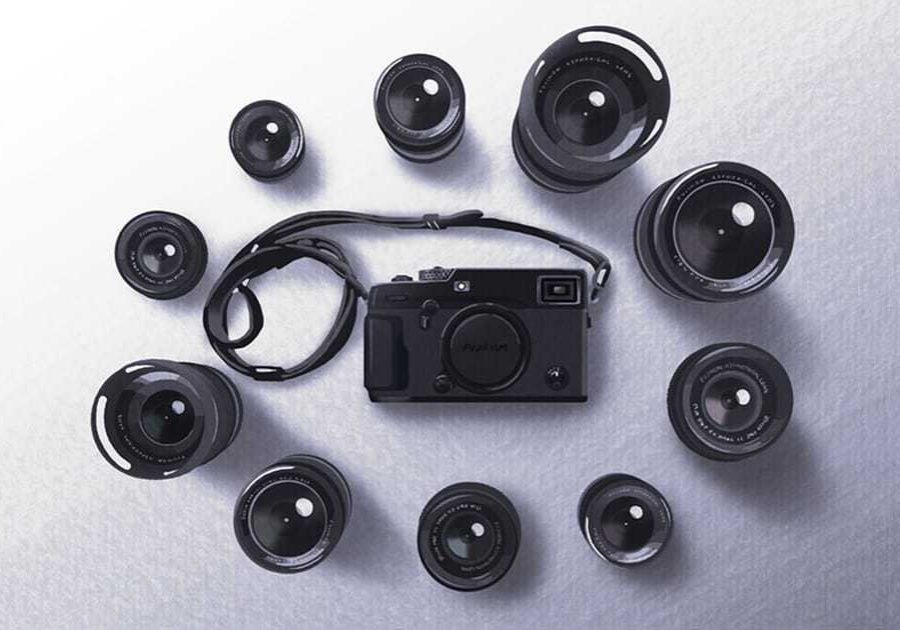
12 Best Fuji Lenses for Fujifilm X Mount (All Budgets)
Discover the best Fuji lenses of the year in this mammoth guide which includes sample photos, expert opinion and more. All budget X-Mount lenses reviewed.
Camera Gear Guides | Fujifilm Lens Guides | Lens Guides | By Greg Cromie | Last Updated: January 10, 2025
Shotkit may earn a commission on affiliate links. Learn more.
If you’re looking for the ultimate guide to Fujifilm lenses, you’re in the right place!
Fujifilm boasts a long and proud history in the optics and imaging industry—it has been an industry leader for over 90 years.
The Japanese company launched the Fuji X Series in 2011 to usher in a new age of accessible and affordable digital mirrorless cameras and lenses.
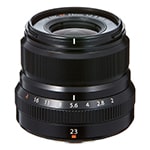
Versatile focal length with outstanding optics in a lightweight, compact and weather-sealed body at a great price.
In our latest roundup of the best Fujifilm lenses, we’ll discover the lineup of X-mount lenses and highlight the cream of the crop.
Fujifilm develops optically accurate and sharp prime and zoom lenses designed for photographers of every genre and skill level.
I’ve got a lot to say on the subject, so let’s dive in.
What are the Best Fuji Lenses Today?
| Image | Product | Features | |
|---|---|---|---|
 | Fujifilm XF 23mm f/2 R WROUR #1 CHOICE |
| Check AMAZON Price → Check B&H Price → |
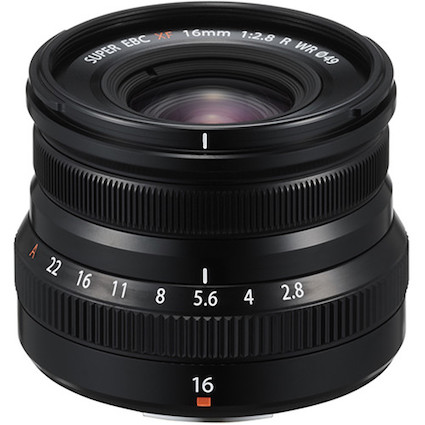 | Fujifilm XF 16mm f/2.8 R WRGREAT VALUE |
| Check AMAZON Price → Check B&H Price → |
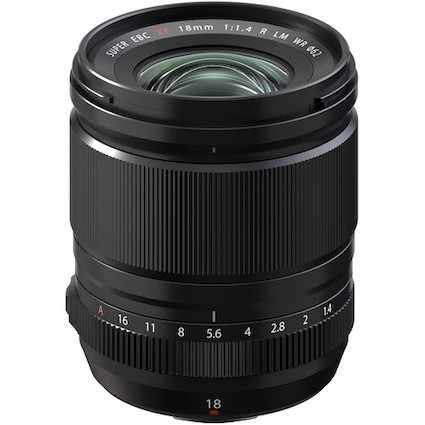 | Fujifilm XF 18mm f/1.4 R LM WRBEST FOR PROS |
| Check AMAZON Price → Check B&H Price → |
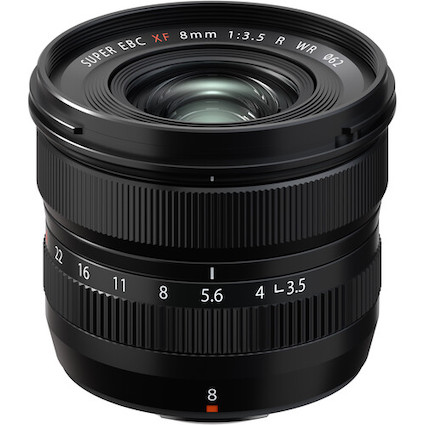 | Fujifilm XF 8mm f/3.5 R WRHIGH QUALITY |
| Check AMAZON Price → Check B&H Price → |
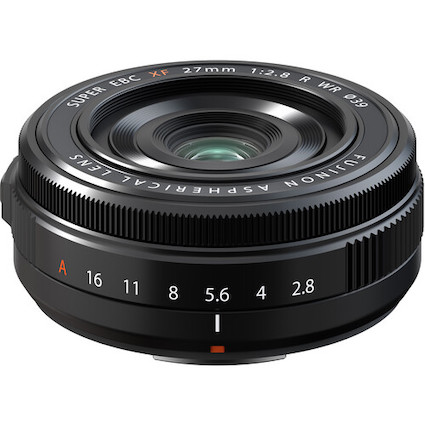 | Fujifilm XF 27mm f/2.8 R WRMOST AFFORDABLE |
| Check AMAZON Price → Check B&H Price → |
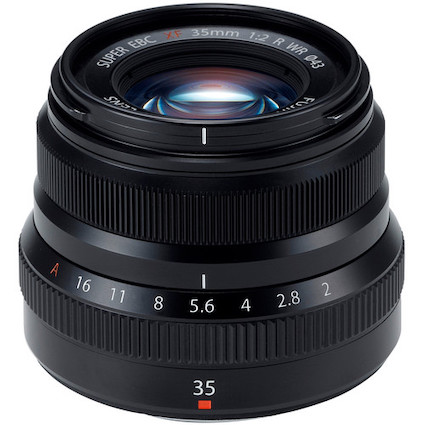 | Fujifilm XF 35mm f/2 R WRGREAT FOCUS |
| Check AMAZON Price → Check B&H Price → |
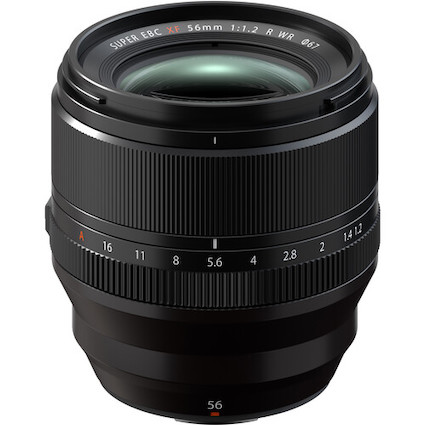 | Fujifilm XF 56mm f/1.2 R WRGREAT APERTURE |
| Check AMAZON Price → Check B&H Price → |
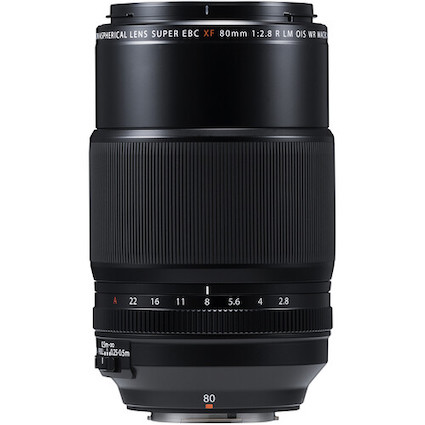 | Fujifilm XF 80mm f/2.8 R LM OIS WR MacroBEST MACRO LENS |
| Check AMAZON Price → Check B&H Price → |
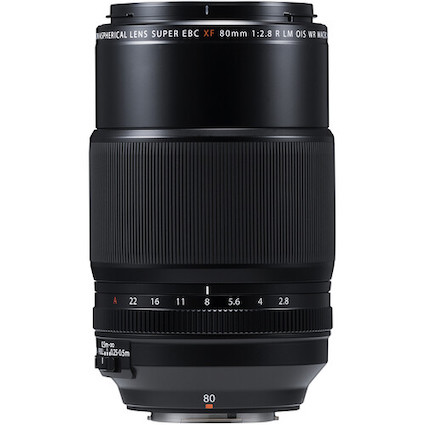 | Fujifilm XF 10-24mm f/4 R OIS WRBEST ALL ROUND ZOOM LENS |
| Check AMAZON Price → Check B&H Price → |
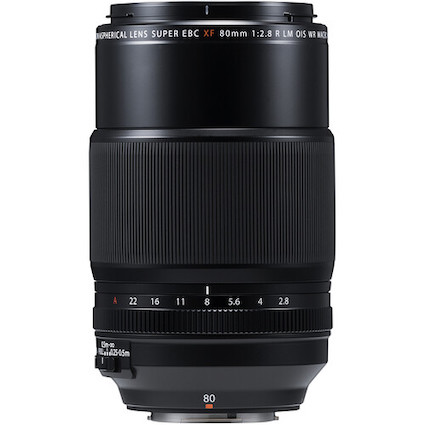 | Fujifilm XF 16-50mm f/2.8-4.8 R LM WRBEST FULL FRAME |
| Check AMAZON Price → Check B&H Price → |
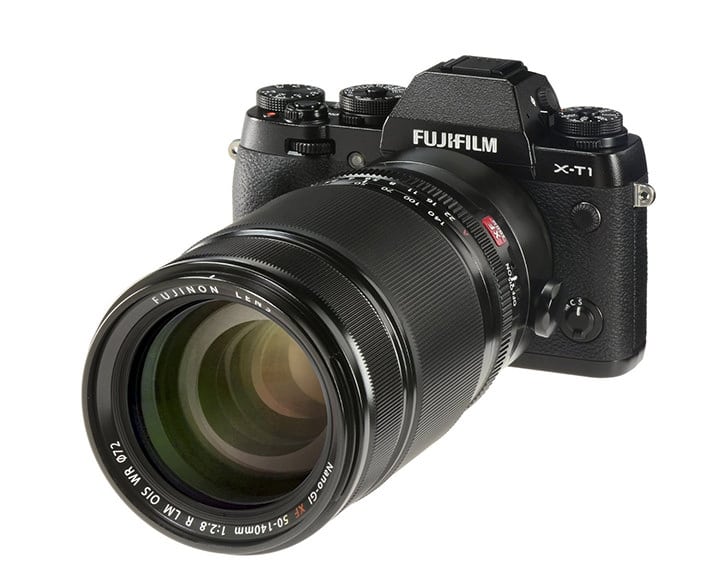 | Fujifilm XF 50-140mm f/2.8 R LM OIS WRBEST MID ZOOM |
| Check AMAZON Price → Check B&H Price → |
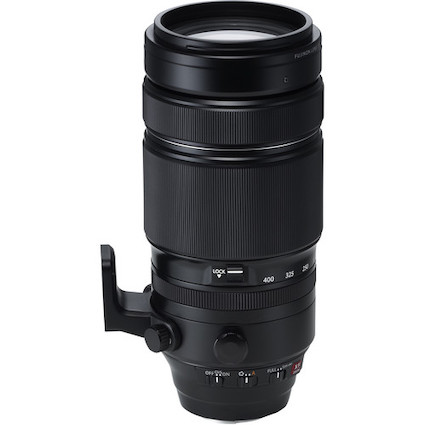 | Fujifilm XF 100-400mm f/4.5-5.6 R LM OIS WRBEST TELEPHOTO LENS |
| Check AMAZON Price → Check B&H Price → |
At the time of writing this updated guide, there are 44 current Fuji X Series lenses, including primes, zooms, teleconverters, and macro lenses.
That’s not counting earlier generations of popular focal ranges that have since been updated or replaced.
While I could easily list all 44 and have great things to say about each, it’s more productive to highlight the best of the X Series range.
The following lenses represent the best glass the Japanese company develops to support entry-level, enthusiast, and professional photographers.
No matter the genre or budget, Fujifilm offers a lens to suit.
1. Fujifilm XF 23mm f/2 R WR
Style: Standard Prime Lens
Aperture: f/2
Focal Length: 23mm (35mm equivalent)
Dimensions: 60 x 51.9 mm (2.36 x 2.04“)
Weight: 180g (0.39lb)
Fujifilm 23mm f/2 Review
The Fujifilm XF 23mm f/2 is my favorite X Series lens, and I can’t recommend it enough!
The 23mm focal range is a 35mm full-frame equivalent with a 63.4º field of view.
Thanks to its natural field of view, fast aperture, and sharp image quality, it’s the ideal everyday lens.
However, I put the fast little lens to use as a street photography and travel lens.
At f/2, subject separation is well defined, and background blur is pleasing to the eye.
Narrow down the aperture to f/8, and you achieve edge-to-edge sharpness across the entire frame.

Fujifilm XF 23mm f/2 R WR
It’s one of the smallest Fuji lenses in the range, so it’s lightweight and incredibly compact.
Furthermore, the weather-sealed XF 23mm f/2 features fast autofocus performance in any lighting conditions.
Regardless of being paired with a flagship Fuji X-T5 or entry-level X-T30 II, the XF 23mm f/2 is brilliant and keeps the kit minimal.
The lens is available in silver or black to suit the Fuji X Series camera of your choice.
If you’re looking for a lens with a 23mm focal range and a faster maximum aperture, the Fuji XF 23mm f/1.4 is one of the sharpest available.
Its wide f/1.4 aperture, fast linear motor focusing system, and durable build make it a great lens. However, it’s a lot bigger and heavier than its little sibling.
2. Fujifilm XF 16mm f/2.8 R WR
Style: Wide Prime Lens
Aperture: f/2
Focal Length: 16mm (24mm equivalent)
Dimensions: 60 x 45.4mm (2.36 x 1.78 “)
Weight: 155g (0.34lb)
Fujifilm 16mm f/2.8 Review
Fuji’s XF 16mm f/2.8 R WR is a super fun lens. It’s compact, lightweight, and a great all-rounder.
The wide 16mm focal range delivers a 24mm full-frame equivalent and an 83.2º field of view.
What’s most appealing about this lens is its versatile use in various photography genres, including landscape and street photography.
It’s wide enough to gain a nice level of composition context without losing detail to an expansive frame.
Given its size, it also pairs well with older Fuji X Series cameras, such as the X-Pro and X-E models.
As for image quality, the weather-resistant Fujifilm XF 16mm f/2.8 delivers excellent sharpness across the frame, especially from f/4 to f/8.

XF 16mm f/2.8 R WR
When shooting wide-open at f/2.8, subject separation is well-defined, and background blur is pleasing.
While the XF 16mm f/1.4 WR is one of Fuji’s oldest lenses, it delivers a wider maximum aperture and exceptional image sharpness.
However, its autofocus performance isn’t on par with newer Fuji lenses.
3. Fujifilm XF 18mm f/1.4 R LM WR
Style: Wide Prime Lens
Aperture: f/1.4
Focal Length: 18mm (27mm equivalent)
Dimensions: 66.8 x 75.6mm (2.63 x 2.97“)
Weight: 370g (0.81lb)
Fujifilm 18mm f/1.4 Review
The Fujifilm XF 18mm f/1.4 R LM WR is an exceptionally sharp, fast, wide-angle prime lens.
Released in 2021, the new 18mm f/1.4 lens superseded the original XF 18mm f/2, which launched with the X-Pro1 in 2012.
The 18mm focal range delivers a much sought-after 24mm full-frame equivalent with a 76.5º field of view.
It’s a triple-threat lens thanks to its f/1.4 maximum aperture, optical sharpness, and quick linear-motor autofocus system.
An 18mm focal range is ideal for a wide range of genres, from landscape and astrophotography to architecture and street photography.
The weather-sealed lens is compact and lightweight and balances well on any Fuji X Series camera body.

Fujifilm XF 18mm f/1.4 R LM WR
The wide prime’s standout feature is its fast f/1.4 maximum aperture, which delivers excellent subject separation, background blur, and depth of field.
With a 20cm minimum focus distance, you can get in super-close to subjects for dynamic wide-angle compositions.
As for the original XF 18mm f/2, it’s now over a decade old, and its slow autofocus is annoying—however, it’s still one of the sharpest wide primes on offer.
It’s a Fuji classic that holds up and pairs well with older Fuji X Series cameras, such as the X-Pro range.
4. Fujifilm XF 8mm f/3.5 R WR
Style: Ultra-Wide Prime Lens
Aperture: f/3.5
Focal Length: 8mm (12mm equivalent)
Dimensions: 68 x 52.8mm (2.67 x 2.07 “)
Weight: 215g (0.47lb)
Fujifilm 8mm f/3.5 Review
The Fujifilm XF 8mm f/3.5 is the widest prime lens in the Fuji X Series range.
It’s a relatively new entry in the series and offers landscape, architecture, and creative photographers the opportunity to capture extreme compositions.
The weather-sealed 8mm lens offers a 12mm full-frame equivalent focal range ideal for capturing wide-angle shots in any situation.
Ultra-wide primes are prone to distortion and lens flare caused by sunlight.
However, the Fuji 8mm ultra-wide prime is optically accurate and delivers aberration-free photos.
Its 121º field of view captures a stunning amount of the vista – and your feet if you’re not careful.
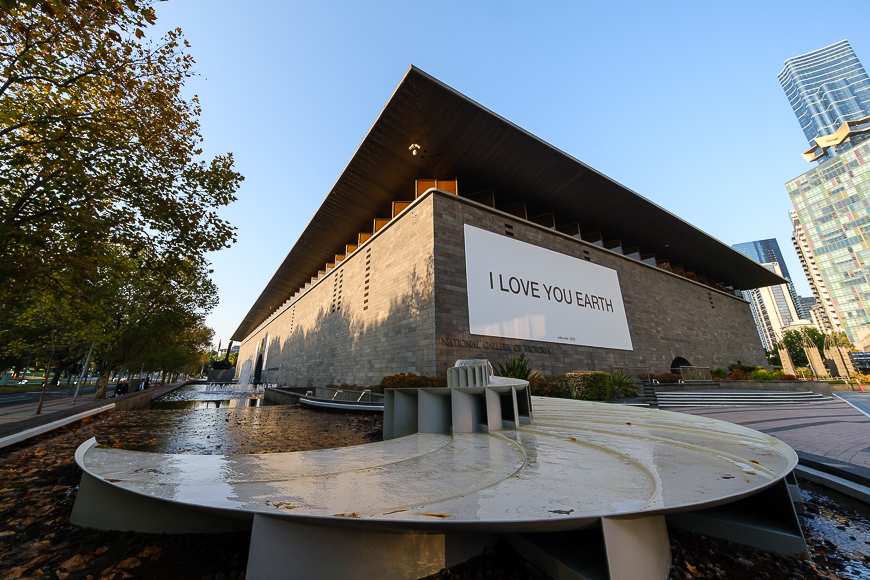
Fujifilm XF 8mm f/3.5 R WR
A word of warning: Be mindful of the sun’s location when framing composition to avoid excessive lens flare or highlights.
The f/3.5 maximum aperture is well suited to landscape and architecture genres and astrophotography opportunities.
It’s robust, lightweight, and compact and includes a wide-flaring lens hood to block excessive outdoor sunlight.
While not as wide, the XF 14mm f/2.8 R wide-angle lens is an excellent alternative. However, it’s an older lens with slower autofocus.
5. Fujifilm XF 27mm f/2.8 R WR
Style: Standard Prime Lens
Aperture: f/2.8
Focal Length: 27mm (41mm equivalent)
Dimensions: 62 x 23mm (2.44 x 0.96“)
Weight: 84g (0.18lb)
Fujifilm 27mm f/2.8 Review
If you thought the XF 23mm f/2 was small, be prepared to witness the tiny Fujifilm XF 27mm f/2.8 R WR.
The truly compact prime lens is the second iteration of Fuji’s 27mm pancake prime.
It was released alongside the Fujifilm X-E4 and instantly caught my eye as an ideal compact street kit. I snapped up both immediately!
The current 27mm f/2.8 offers excellent image sharpness, precise aperture control, and quick focusing in a weather-sealed body.
27mm delivers a 55.5º angle of view and a 41mm full-frame equivalent focal range.
When I say that the Fuji 27mm is compact, I mean it’s the smallest and lightest lens in the entire range.
At just 23mm thick and weighing 84g, it’s a pocketable everyday carry lens ideal for family activities and travel.

XF 27mm f/2.8 R WR
Aside from its astounding size, the lens outputs sharp, distortion-free images throughout the aperture range.
When paired with a Fuji X Series camera, such as an X-T5, the combined kit looks more like a film camera than a current-gen digital one.
If you’re looking for an alternative compact prime lens, the XF 23mm f/2 or XF 35mm f/2 are ideal.
6. Fujifilm XF 35mm f/2 R WR
Style: Standard Prime Lens
Aperture: f/2
Focal Length: 35mm (53mm equivalent)
Dimensions: 60 x 45.9mm (2.36 x 1.8“)
Weight: 170g (0.37lb)
Towards the end of 2015, Fuji embarked on a journey to deliver greater choice and creative freedom to X Series photographers.
The Fujifilm XF 35mm f/2 R WR compact prime lens was the first release in a series referred to as Fujicron.
As a compact and lightweight prime lens, it offered a 53mm full-frame equivalent focal range, sharp optics, and a wide maximum f/2 aperture.
Fuji already offered a popular 35mm f/1.4 prime lens, but it wanted to offer a more accessible and affordable option.
The 35mm f/2 was soon followed by the XF 23mm f/2, 50mm f/2, and later the wider 16mm f/2.8.
These compact primes are smaller, lighter, and cheaper than the enthusiast-level X Series primes.

XF 35mm f/2 R WR
The 35mm f/2 is also available in silver or black, and the silver model looks impressive on a silver X-T5.
The weather-sealed 35mm offers fast focus performance, excellent image quality, and great depth of field wide open.
It’s another excellent choice for travel, street or everyday photography adventures.
The Fuji XF 35mm f/1.4 is still listed as an available lens and is an excellent choice for those looking for a wider aperture.
7. Fujifilm XF 56mm f/1.2 R WR
Style: Telephoto Prime Lens
Aperture: f/1.2
Focal Length: 56mm (85mm equivalent)
Dimensions: 79.4 x 76mm (3.12 x 2.99“)
Weight: 445g (0.97lb)
Fujifilm 56mm f/1.2 Review
The Fujifilm XF 56mm f/1.2 R WR is one of the sharpest X Series lenses ever and is ideal for portrait photographers.
The XF 56mm f/1.2 is a popular focal range for portraiture thanks to its 85mm full-frame equivalent and tighter 28.5º field of view.
The R WR version of the lens is Fuji’s third generation of optically brilliant long primes with a 56mm focal range.
The original XF 56mm f/1.2 (released in 2014) was equally sharp; however, being one of the earliest Fuji lenses, it offered sluggish autofocus.
Later, the same year, Fuji released a second 56mm lens with the XF 56mm f/1.2 APD.
It offered an altered lens configuration with an Apodization filter to create a creamier background blur ideal for portraits.
The latest gen 56mm f/1.2 offers a solid weather-sealed body, impressive autofocus performance, and some of the sharpest images you’ll see in any lens from any brand.

XF 56mm f/1.2 R WR
The wide f/1.2 maximum aperture offers superior low-light performance and appealing subject separation, making it ideal for headshots and portraits.
I’ve shot with each of the XF 56mm f/1.2 lenses Fuji has offered over the years and this one is the best yet!
Because it’s such a high-quality portrait lens, it’s more expensive than the user-friendly Fuji XF 50mm f/2.
Alternatively, if you’re looking for an even wider max aperture, the Fuji XF 50mm f/1 R WR is divine!
At f/1, subject sharpness, definition, background blur, and bokeh are unparalleled.
8. Fujifilm XF 80mm f/2.8 R LM OIS WR Macro
Style: Telephoto Macro Lens
Aperture: f/2.8
Focal Length: 80mm (122mm equivalent)
Dimensions: 80 x 130mm (3.15 x 5.11“)
Weight: 750g (1.65lb)
Fujifilm 80mm f/2.8 Macro Review
One of the very first X Series lenses released in 2012 was the XF 60mm f/2.4 R 2:1 Macro lens.
Fuji demonstrated their desire to offer a range of lenses suited to even the most niche genres.
The Fujifilm XF 80mm f/2.8 continues to offer macro photographers essential imaging options to capture exceptional macro images.
While the 80mm is bigger and heavier than the 60mm f/2.4 Macro lens, it delivers a true 1:1 magnification ratio, ideal for enthusiast macro photography.
It’s one of the most optically impressive lenses in the X Series, and with its 120mm full-frame focal range, it’s just as effective as a portrait lens.

XF 80mm f/2.8 R LM OIS WR Macro
Fuji’s XF 80mm f/2.8 features a focus-limiting switch, optical image stabilization, and super-fast linear motor autofocus.
The 25cm minimum focus distance ensures you won’t poke your creepy crawly in the eyes just to get a sharp shot.
You can stand back a bit and frame your shot without disturbing the nature on display.
The fast f/2.8 maximum aperture ensures precise center subject sharpness and highly appealing background effects.
While the XF 60mm f/2.4 Macro is a great alternative, Fuji also offers the XF 30mm f/2.8 R LM WR Macro lens.
It’s far more compact and affordable than the bulkier XF 80mm f/2.8 option.
9. Fujifilm XF 10-24mm f/4 R OIS WR
Style: Wide Zoom Lens
Aperture: f/4
Focal Length: 10-24mm (15-36mm equivalent)
Dimensions: 77.6 x 87 mm (3.05 x 3.42“)
Weight: 385g (0.84lb)
It’s time to look at some of the best Fuji X Series zoom lenses covering focal ranges from 8mm up to 600mm.
The Fuji XF 10-24mm f/4 R OIS WR wide-angle zoom is one of the most versatile X-mount lenses.
Its 10-24mm APS-C focal range delivers a 15-36mm full-frame equivalent, making it ideally suited to landscape and architecture.
Fuji’s 10-24mm f/4 is one of the most popular lenses among X Series astrophotographers due to its variable field of view and narrower aperture.
Released in 2020, the current generation XF 10-24mm features Optical Image Stabilisation and a weather-sealed body – the original 10-24 wasn’t weatherproof.
The XF 10-24mm f/4 features a flexible wide-angle zoom range, allowing photographers to compose wider shots effortlessly.
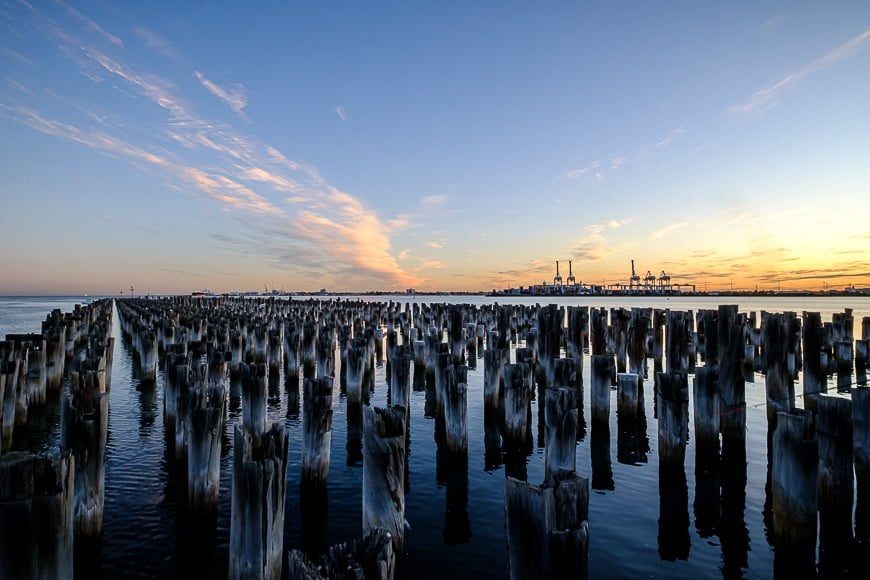
XF 10-24mm f/4 R OIS WR
Thanks to the inclusion of OIS, handheld photography is possible even at lower shutter speeds where camera shake could ruin shots.
With a standard 72mm filter thread, landscape photographers can quickly employ ND and Polarizing filters for optimal image quality.
If you’re looking for a wider zoom lens, the optically accurate Fuji Red Badge XF 8-16mm f/2.8 is hard to ignore.
While it’s double the price of the 10-24mm, it delivers exceptional image sharpness and depth of field in any lighting conditions.
10. Fujifilm XF 16-50mm f/2.8-4.8 R LM WR
Style: Standard Zoom Kit Lens
Aperture: f/2.8-4.8
Focal Length: 16-50mm (24-75mm equivalent)
Dimensions: 65 x 61.4mm (2.55 x 2.41“)
Weight: 240g (0.52lb)
Fujifilm 16-50mm f/2.8-4.8 Review
The Fujifilm XF 16-50mm f/2.8-4.8 is the newest kid on the block.
Intended to replace the highly acclaimed XF 18-55mm f/2.8-4 kit lens, the XF 16-50mm is designed to support the demands of the newer 40MP X cameras.
The Fuji XF 16-50mm offers a highly flexible 24-70mm full-frame equivalent focal range.
It’s one of the most versatile lenses in the Fuji X Series range and is the perfect everyday or travel zoom.
At the wide 16mm end, capture landscapes or city scenes with edge-to-edge sharpness. Zoom to 50mm for tighter compression and compositions such as portraiture, food, and products.
While it’s designed to be a kit lens included with most X Series cameras, it’s a stunning choice in its own right.
The original XF 18-55mm f/2.8-4 kit lens was hot-property on the second-hand market as Fuji shooters loved its capabilities.

XF 16-50mm f/2.8-4.8 R LM WR
Its linear motor focusing system delivers lightning-quick performance, especially when using subject detection on a flagship X-T5 or enthusiast-level X-T50.
The f/2.8 maximum aperture produces appealing subject separation and background blur at 16mm.
However, the narrower f/4.8 aperture at the 50mm end isn’t ideal, especially in low-light situations. As a result, it’s hard to recommend as a serious portrait lens.
Fuji missed an opportunity to add OIS for slow shutter speed photography.
A pro-level alternative is the Red Badge Fujifilm XF 16-55mm f/2.8, which delivers next-level image sharpness and performance in any situation.
11. Fujifilm XF 50-140mm f/2.8 R LM OIS WR
Style: Telephoto Zoom Lens
Aperture: f/2.8
Focal Length: 50-140mm (76-213mm equivalent)
Dimensions: 82.9 x 175.9mm (3.26 x 6.92“)
Weight: 995g (2.18lb)
Fujifilm 50-140mm f/2.8 Review
As a Fuji photographer and reviewer, I’ve shot with almost every zoom and prime lens in the X Series range.
However, the Fujifilm XF 50-140mm f/2.8 is one of the best lenses I’ve ever shot with.
It’s a bit embarrassing to admit, but I “accidentally” bought the Fuji 50-140mm on a drunken night adventure in Kyoto, Japan.
Putting aside my shameful behavior and credit card debt, it proved to be an incredibly fast and sharp Red Badge zoom lens.
The constant f/2.8 maximum delivers exceptional subject separation and background blur with accurate image sharpness and clarity.
Paired with a flagship Fuji X-T5, the XF 50-140mm f/2.8 is a powerhouse in almost any setting and genre.
The 76-213mm full-frame equivalent focal range is ideal for portraits, products, motorsport, and birding.

XF 50-140mm f/2.8 R LM OIS WR
With Optical Image Stabilization and fast linear motor autofocus, it snaps from subject to subject without hesitation.
While the weather-sealed body is heavier than most lenses, it’s one of the most robust and impressive pieces of optical tech on the market.
With Fuji being Fuji, there’s a fantastic and affordable alternative to the premium XF 50-140mm zoom lens.
The Fujifilm XF 55-200mm f/3.5-4.8 R LM OIS is the unsung hero of the X Series zoom lens range.
The 55-200mm focal range delivers a highly versatile 84-305mm full-frame equivalent ideal for multiple photography disciplines.
At the 55mm wide end, it’s suitable for portraiture and product work. At the 200mm end, the optically image-stabilized lens is well suited to sports and wildlife photography.
12. Fujifilm XF 100-400mm f/4.5-5.6 R LM OIS WR
Style: Super-Telephoto Zoom Lens
Aperture: f/4.5-5.6
Focal Length: 100-400mm (152-608mm equivalent)
Dimensions: 94.8 x 210.5mm Wide/270mm Telephoto (3.73 x8.28” Wide/10.63” Telephoto)
Weight: 1,375 g (3.02lb)
One of the biggest lenses in the Fuji X Series fleet is the XF 100-400mm f/4.5-5.6 R LM OIS WR.
The weather-sealed lens is a beast weighing 1,375g and measuring 94.8 x 270mm when the zoom is extended to 400mm.
With a 200-600mm full-frame equivalent focal length, the super-telephoto zoom is a formidable ally for birding, wildlife, and sports.
The Fujifilm XF 100-400mm f/4.5-5.6 also features Optical Image Stabilization, fast linear motor autofocus, and exceptional image sharpness across the focal range.
The f/4.5-5.6 maximum aperture is ideally suited to super-telephoto work, ensuring image sharpness and subject separation at long distances.
The XF 100-400mm f/4.5-5.6 is also compatible with the pair of Fuji XF Teleconvertor lenses.

Fujifilm XF 100-400mm f/4.5-5.6 R LM OIS WR | Igor Vyvey
The XF 1.4X Teleconverter extends the focal range to 140-560mm with a minimal drop in maximum aperture.
Add the XF 2.0X Teleconverter to the lens, and your focal range will magnify to 200-800mm! However, it comes at the cost of image sharpness and optimal aperture.
Professional Fuji photographers looking for the ultimate zoom lens should look at the monolithic XF 150-600mm f/5.6-8 R LM OIS WR.
It’s big, bold, and beautiful—as are the images captured with this incredible piece of kit!
If you’re looking for something a little cheaper, the XF 80-300mm f/4-5.6 R LM OIS WR telephoto lens is hard to pass up.
It’s also worth noting that the XF 1.4X and XF 2.0X Telecopnverters pair with both these lenses for extended reach.
The Best Lenses For Different Fuji Cameras
As a member of a large Fuji community, I get asked questions about the best Fuji lenses for a particular camera.
Having shot with, tested, and reviewed almost every Fuji X Series camera and lens, it’s easy to know the best lenses to pair with each camera.
Keep reading if you’re looking for a camera and lens combo other than the kit lens that comes in the box.
The recommended pairings below are based on what lenses best complement the camera, its intended user, and the style or genre it’s best suited to.
Of course, any Fuji lens will pair with any Fuji X Mount camera – but some combinations just feel right.
Fujifilm X-T5

Fujifilm X-T5 and XF 56mm f/1.2
The Fujifilm X-T5 is the flagship photography camera developed by the Japanese imaging giant.
It features a 40MP APS-C CMOS X Trans 5 image sensor, X Processor 5, and 5-axis in body image stabilization, delivering an additional 7 stops of light.
The X-T5 also offers fast autofocus performance, targeted subject tracking, and the ability to record 6.2K/30p high-resolution video.
The best lens to pair with the X-T5 is the Fujifilm XF 56mm f/1.2.
The 56mm (85mm full-frame) focal range is ideal for portraiture, food, and product photography.
While the 56mm f/1.2 R WR doesn’t feature OIS, the wide aperture and X-T5 IBIS are more than enough to shoot in low light.
The X-T5 and XF 56mm f/1.2 look and feel good together and deliver outstanding pro-grade images.
Check out our complete guide to the best lenses for the X-T5.
Fujifilm X-T50

Fujifilm X-T50 + XF 16-50mm f/2.8-4.8
When Fujifilm launched the X-T50, it released the new XF 16-50mm f/2.8-4.8 kit lens.
The 16-50mm f/2.8-4.8 is specifically suited to optimize image quality, sharpness, and the autofocus performance of newer 40MP X Series cameras.
As a result, it’s the most accessible, flexible, and affordable lens for the X-T50. Plus, it features the latest and greatest tech from Fuji.
The X-T50 is a perfect Fuji camera for photography enthusiasts looking to optimize their creative output.
The XF 16-50m suits many genres while delivering excellent outcomes.
It’s also a great combo to learn or master photography before moving on to high-grade gear.
I recently reviewed the X-T50 and fell for its Film Simulation Dial and fantastic performance.
Fujifilm X-H2S

The Fujifilm X-H2S is the company’s flagship hybrid photography and videography digital mirrorless camera.
While it captures incredible image quality, it’s the best Fuji camera for pro-grade video recording.
The X-H2S features a 26MP X-Trans CMOS 5 HS image sensor, fast X Processor 5, In Body Image Stabilization, and Digital Stabilization for video.
It also boasts a larger and deeper grip than any other Fuji X Series camera. As a result, it’s excellent for shooting with larger Fuji zooms.
A premium, high-spec camera like the X-H2S pairs perfectly with the Red Badge Fuji XF 16-55mm f/2.8.
While the combo is heavier and bulkier than most, its performance and image quality are second to none.
Fujifilm X-S20

Fujifilm’s X-S20 is another hybrid video and photography camera ideal for vlogging.
The X-S20 houses a 26.1MP X-Trans CMOS 4 image sensor and fast X Processor 5 driving the 5-axis image stabilization, delivering up to 7 stops of light.
Videographers and vloggers love the 6.2K 30p and 4K 60p video performance.
Like the X-H2S, the X-S20 features a deeper grip that allows for added comfort and control.
One of the best Fuji lenses for vlogging is the lightweight XF 16mm f/2.8 R WR.
The combined weight of the camera and 16mm lens is 646g (1.42lb), making it an ideal kit for handheld vlogging or with a gimbal.
Be sure to read our full X-S20 review.
Advice From The Pros: The Best Fuji Lens For The Job
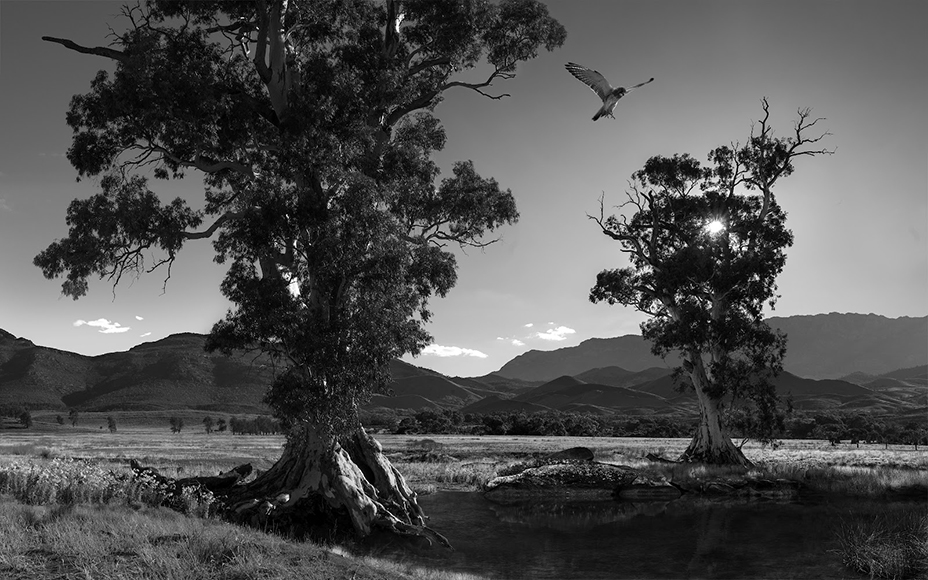
Image Credit: Two Trees by Gary Heery using a Fujifilm GF 32-64mm lens
Fujifilm cameras and lenses aren’t just for entry-level and enthusiast photographers.
More and more pro photographers are turning to Fujifilm to meet and exceed their creative and commercial needs.
We chatted with several pro photographers to get their advice on selecting the right Fujifilm lens for the job.
Portrait photography
“Zoom lenses will always be my go-to, with most of my shots being taken between 70-100mm on the GF45-100mm f/4 R LM OIS WR as it means images are cropped and at their most flattering. It also means the subject can be captured from a distance, and there is a strong sense of intimacy, particularly when used in conjunction with a tripod,” says Gary Heery, Fujifilm X-Photographer.
Andrew Hall, another Fujifilm X-Photographer, says he prefers primes for portraits. “It’s always good to start with a plan of what you’re hoping to achieve in any shoot, including what style of photography you like, the desired size and speed of the lens, and, of course, the budget!
“For portrait photography, I prefer a prime lens such as the XF 90mm f/2.0 because of its sharpness and bokeh,” he says.
Fast-moving photography
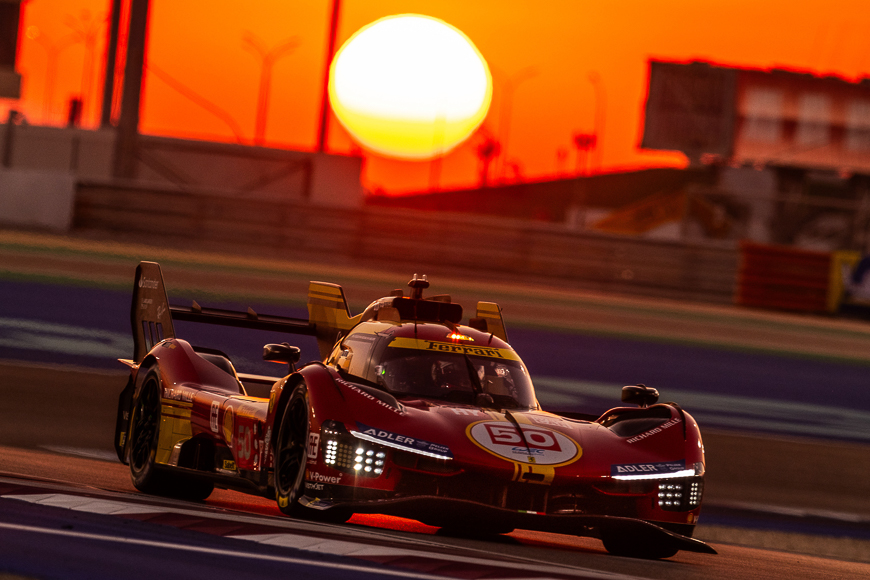
Fujifilm X-H2 | Fujifilm XF 200mm f/2 + 1.4x Teleconverter | Velvia Film Simulation | Andrew Hall
Says Andrew Hall: “Finding a lens that can keep up with the stealth and speed required to capture fast-moving objects can prove challenging. When it comes to action photography, the XF 100-400mm and XF 70-300mm are always with me as they are renowned for their sharpness and clarity.
“However, my current favorite lens for any racetrack action is the new FUJINON XF 150-600mm lens, as it provides extra reach and is razor-sharp throughout the zoom range.
“Not only this, but the zoom function in the XF 150-600mm lens is internal, meaning the balance of the lens stays the same throughout the zoom range, which is a definite advantage at longer focal lengths,” he says.
Landscape Photography
Says Gary Heery, “Many photographers tend to lean toward a zoom lens when shooting landscape photography as it means there is a bit more versatility on a shoot. One of the limitations of a prime lens is that the only way to zoom in and out is to move to the ideal location for the frame.
That’s why I like to use the XF 100-200mm f/4.5-5.6 R LM OIS WR however I am usually using shorter focal lengths as I prefer the intimacy it creates.”
“When I’m out shooting landscape photography, I tend to reach for a wide-angle zoom lens such as the XF 10-24mm zoom,” says Hall. “However, I also use the new XF 18mm f/1.4 interchangeably.”
“When it all comes down to it, it’s up to the preferred aesthetic of each photographer as to what lens should be used, but hopefully, photographers can feel more equipped with additional context and knowledge to make the best decision for themselves,” he adds.
How To Choose The Right Fuji Lens For You
Before you rush out and buy every lens we’ve recommended, stop and consider the style and genre of photography you want to explore the most.
I’m a big advocate for using the lens you already have in your kit rather than instantly searching for the perfect one for the job.
However, there’s a method to my madness, and I’ve provided some simple steps below to help you make the right choice.
Baby Steps

As a beginner, it’s far better to make the most of the lenses already in your camera bag, even if that lens is the older 18-55mm f/2.8-4 kit lens or the new 16-50mm f/2.8-4.8 zoom.
Speaking of kit lenses, it’s the perfect place to begin your exploration of Fujifilm lenses.
Especially since most Fujifilm X Series cameras are available as a kit – depending on your region.
I recommend you work with the 16-50mm kit lens to explore as many photography genres as possible.
Shoot landscapes and city views at the wide 16mm end with a range of apertures. Then zoom in close at 50mm and capture portraits, products, pets, and food.
Take photos in every room of your home regardless of the lighting conditions.
Review your photos and understand what focal length and aperture you prefer to shoot with.
You may prefer the look, feel, and outcomes of the photos captured at 16mm with an aperture of f/2.8.
Or it could be that you sometimes wished you had something wider to capture more of the scene.
Considering these factors, a wider zoom lens, such as the XF 10-24mm f/4 or the XF 8-16mm f/2.8, is worth investing in.
Walk Before You Run

Apply the same principle if you would prefer a single-focal-distance or prime lens after extensive use of the 16-50mm kit lens.
First, get out and take lots of photos of the things you love the most. Review your images to discover your most used focal length and aperture.
Consider whether you’re happy with the compositions and recall whether you zoomed in or out with your feet to get the framing right.
Upon review, you may discover that you prefer the 50mm focal distance; however, you would love a wider maximum aperture.
If that’s the case, try out the Fuji XF 50mm f/2 or the enthusiast-level XF 56mm f/1.2.
Watch Where You Step

My final advice on selecting and buying Fuji XF lenses is to take your time.
In the past, I’ve suffered extensively from GAS (Gear Acquisition Syndrome) and FOMO (Fear Of Missing Out), which resulted in me buying up Fuji lenses to have a lens for every occasion.
It’s an expensive and stressful trap! Today, I have a ‘less is more’ philosophy and work with a very minimal Fuji lens kit.
Move on from the kit lens, but not before getting the most out of it first.
With your next lens, apply the same principles of making it work in as many genres as possible to master any situation.
Don’t be afraid to rent or loan Fuji lenses from camera stores or friends to test them before laying down any more cash.
If you’re looking for a particular Fuji lens to master a specific photography genre, keep reading!
Quick-Fire Lens Choice By Genre

Pick a genre, any genre, and we’ve got a quick-fire Fuji lens recommendation for you!
While there are multiple Fujifilm lens choices for most photography genres, I’ve recommended the best of the bunch.
In saying that, I’ve considered price, performance, features, and potential output.
Astrophotography: The Fujifilm XF 10-24mm f/4 R OIS WR is the best lens for capturing wide expanses of the sky and the galactic core of the Milky Way. Its weather-sealing is perfect for stargazing on cold nights.
Birding: A birding lens must be durable and feature image stabilization, fast focus performance, and super-telephoto reach. The Fujifilm XF 150-600mm f/5.6-8 R LM OIS WR ticks all those boxes while delivering superior image quality.
Motorsport: The Fuji XF 200mm f/2 R LM OIS WR is an ultra-fast super-telephoto prime lens ideally suited to motorsport photography. It’s the biggest and most expensive Fuji lens, and it is also one of the fastest.
Street: As a street photographer, I recommend the XF 23mm f/2 R WR prime lens. It’s compact, lightweight, and incredibly discreet. For its price, it’s also reliable, fast and very sharp.
Weddings & Events: Wedding and event photographers depend on reliable, fast, ultra-sharp lenses that perform in any lighting condition. The Fuji XF 16-55mm f/2.8 R WR is one of the sharpest lenses on the market and ideal for this genre.
Architecture: The Fuji XF 8mm f/3.5 R WR is one of the best lenses for indoor and outdoor architectural photography. It delivers a jaw-dropping view while ensuring image sharpness and distortion-free framing.
Landscape: Landscape is one of the most popular photography genres. Fuji offers many high-quality lenses to suit the genre, but one of the best is the XF 8-16mm R LM WR. It’s optically accurate and produces stunning image quality in any setting.
Headshots/ Portraits: The XF 56mm f/1.2 R WR is arguably one of the sharpest Fuji lenses available. Its telephoto focal range delivers excellent compression, exceptional subject sharpness, gorgeous background blur, and bokeh.
Fashion: The perfect Fuji lens for fashion photography is the XF 50-140mm f/2.8 R LM OIS WR. It features a versatile focal range and is incredibly sharp throughout that range. It’s also a great lens for product shots.
Food: Fuji’s XF 90mm f/2 is another sharp, fast prime lens ideal for food photography. Its 90mm focal range and fast aperture produce tight compressions in any lighting.
Macro: The Fujifilm XF 80mm f/2.8 Macro lens delivers true-to-life close-up shots with a 1:1 magnification ratio. It’s exceptionally sharp and features fast LM autofocus and image stabilization. Try it as a portrait lens, and you’ll be blown away!
Family/Travel: Family photography is often spur of the moment and demands a lightweight, fast, and flexible lens. As a result, the Fuji XF 16-50mm f/2.8-4.8 is perfect for this genre as it’s optically sharp and has lightning-fast focus performance.
How To Read A Fujifilm Lens
All brands rely on acronyms and abbreviations to detail the specifications of each lens.
Below is a glossary of terms to simplify reading a Fuji lens. These terms often appear on the box and the front of each lens.
Getting to know them means you can assess a lens’s qualities and special features at a glance.

XF – Fuji lens series featuring the X Mount for Fujifilm interchangeable lens cameras.
#mm – Focal range is represented in millimeters. Prime lenses list a single focal range, and zoom lenses list the minimum and maximum focal range, for example, 10-24mm.
F – The number following the F represents the lens’s maximum aperture. Prime lenses and zooms with a constant max aperture list a single value such as f/2.8.
R – Lenses marked R feature an aperture ring to control the internal lens aperture opens.
WR – The weather-resistant lens features sealing to keep moisture and dust out.
OIS – Optical Image Stabilisation prevents blurry images caused by lens movement.
LM – Linear Motor autofocus system is fast, near-silent, and highly responsive.
Super EBC – Super Electron Beam Coating is a multi-layer lens coating that minimizes flare and ghosting.
Fujinon Aspherical Lens – An aspherical lens directs the rays of light from all its points to a central point for optimal image sharpness.
⌀## – The filter thread diameter is located at the front of the lens.
Are Fujifilm Lenses Expensive?
As with any high-quality photography equipment, value for money and budget limitations impact what appears on our wishlist and what makes it into our kit.
Fuji lenses are exceptionally well built, made from durable materials, and feature some of the industry’s sharpest and most accurate optics.
Ninety years of experience developing glass lenses tends to make you an expert.
However, it’s essential to understand the cost of a Fuji lens based on the quality of its optics and range of features.
Pro-Level Fuji Lens Kits

Professional and enthusiast photographers looking for the best lens for the job have much to celebrate.
Of course, premium-quality lenses, such as the Red Badge XF zooms, come with a premium price tag.
For example, the Fuji XF 50-140mm f/2.8 retails for around US$1,600, and the stunningly sharp XF 16-55mm f/2.8 retails for US$1,200.
These lenses are ideal for professional wedding and event photographers looking for a dual-zoom kit. Pros in this genre often shoot with two X Series camera bodies.
This pro-level lens combo is an exceptional value for around US$2,800.
Entry-Level Fuji Lens Kits
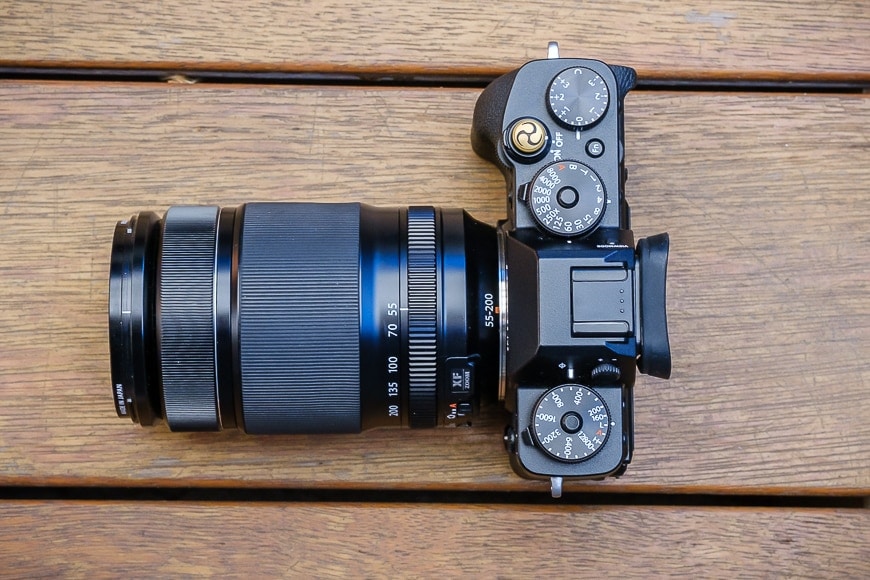
However, not everyone can afford a pair of pro-grade Fuji XF Red Badge zooms at that price.
Fortunately, Fuji’s focus on making photography accessible means that there’s an affordable alternative for every pro-grade lens.
For example, the Fujifilm XF 55-200mm f/3.5-4.8 retails for around US$650, and the new kit XF 16-50mm f/2.8-4.8 retails for around US$870.
The pair costs around US$1,500 and offers almost identical focal ranges and excellent performance to the above pro-kit.
Fuji XF Lens Pricing
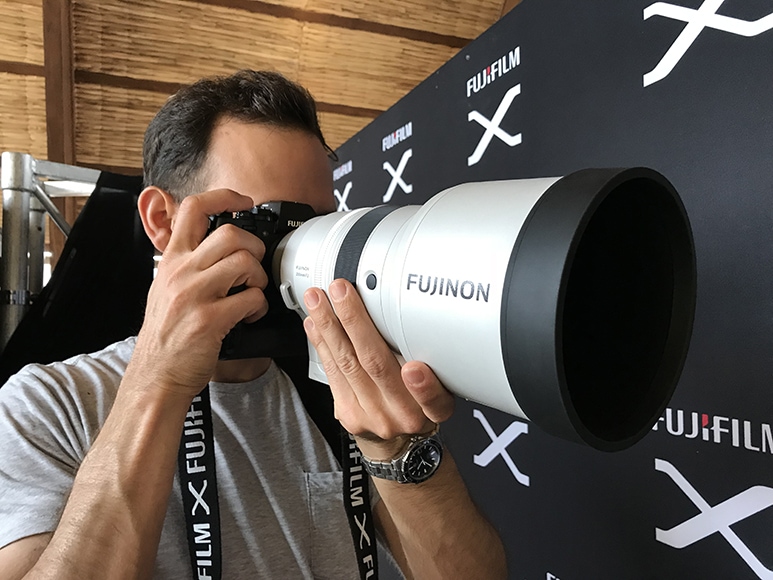
As for the cheapest Fuji XF lens, that award goes to the XF 35mm f/2, retailing for around US$400.
Fuji also offers an XC 35mm f/2 for under $270. The XC lenses feature plastic bodies and lens mounts and are kit lens alternatives for entry-level X Series cameras.
At the other end of the price chart, the Fujifilm XF 200mm f/2 R LM OIS WR and XF 1.4x Teleconverter retail for a staggering US$5,500.
It’s one of the most incredible lenses I’ve ever seen and delivers exceptional image quality and performance suited to motorsports.
The runner-up prize for the most expensive Fuji lens goes to the Fuji XF 150-600mm f/5.6-8, which costs around $2,400.
It’s also worth noting that Fuji makes a pair of professional cine lenses with the same X-mount as the XF series.
The MKX 50-135MM T2.9 and the MKX 18-55MM T2.9 retail for around US$4,300 each.
How Big Are Fujifilm Lenses?
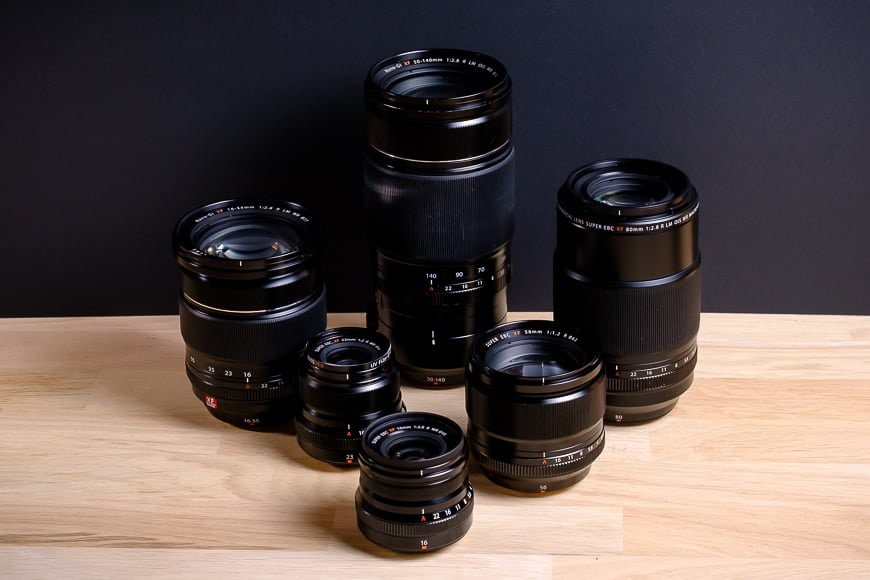
One of the standout features of Fuji lenses and Fuji X Series Cameras is their compact size and durable build qualities.
Of course, the higher-priced pro-grade XF lenses are often heavier and bulkier than the more affordable options.
The Fujifilm XF 50mm f/1 professional portrait lens weighs 845g (1.86lb) and measures 87 × 103.5mm (3.42 x 4.07”). It also retails for around US$1,700.
However, the Fuji XF 50mm f/2 is an optically sharp and fast-focus lens weighing just 200g (0.44lb) and measures 60 x 59.4mm (2.36 x 2.34”). It retails for around US$470.
The smallest Fuji XF lens in the range is the pocketable XF 27mm f/2.8 R WR pancake lens. It weighs a remarkable (or unremarkable) 80g (0.18lb) and measures 62 x 23mm (2.44 x 0.91”).
For comparison, the beastly XF 200mm f/2 R LM OIS WR weighs over 28 times the 27mm!
It’s the heaviest XF lens, weighing 2,265g (4.99lb), and measures 122 x 205.5mm (4.8 x 8.09”) with a 105mm filter thread.
The longest Fuji XF lens is the whopping XF 150-600mm f/5.6-8, which measures 99 x 314.5mm (3.9 x 12.38”).
It’s also important to consider the size and weight of Fuji lenses compared to other brands.
How Do Fuji Lenses Compare To Other Brands?

Years ago, I switched from a Canon DSLR to a Fuji X mount because I found the Canon gear too heavy—it was killing my joy of photography.
The Canon RF 35mm f/1.4L VCM prime lens weighs 555g (1.22lb) and measures 76.5 x 99.3mm (3.01 x 3.91”).
Sony’s FE 35mm f/1.4 GM weighs 524g (1.2lb) and measures 76 x 96mm (3 x 3.8”).
The Fuji XF 23mm f/1.4 (35mm full-frame equivalent) weighs 375g (0.83lb) and measures 67 x 77.8mm (2.64 x 3.06”).
There’s also a price difference of over US$670, with the Fuji being the cheaper option.
While it may not sound like the Canon or Sony options are much bigger or heavier, carrying four to five lenses adds up.
I prefer Fujifilm prime lenses over zooms, so I have several fast, lightweight, compact primes in my kit.
My current Fuji X Series photography kit includes the XF 16mm f/2.8, 23mm f/2, 27mm f/2.8 and 50mm f/2.
All four lenses fit neatly into a messenger-style camera bag, and their combined weight is only 585g (1.29lb).
I currently shoot with a Fujifilm X-E4, which weighs 364g (0.8lb) and, paired with the pancake XF 27mm f/2.8, 444g (0.98lb).
It’s plain to see that Fuji lenses are lighter and smaller than equivalent lenses from other brands.
The Best Third-Party Lenses For Fuji X Mount
Given the rising popularity and interest in the Fuji X Series cameras, third-party brands are making hay while the Rising Sun still shines.
Many experienced optics and lens manufacturers offer X-mount lenses that pair seamlessly with the Fuji X cameras.
Leading and renowned optics brands such as Zeiss, Sigma, Tamron, and Samyang continue to develop X-mount lenses.
Competition from third-party lens brands results in greater choice and fairer pricing.
Zeiss Touit 32mm f/1.8
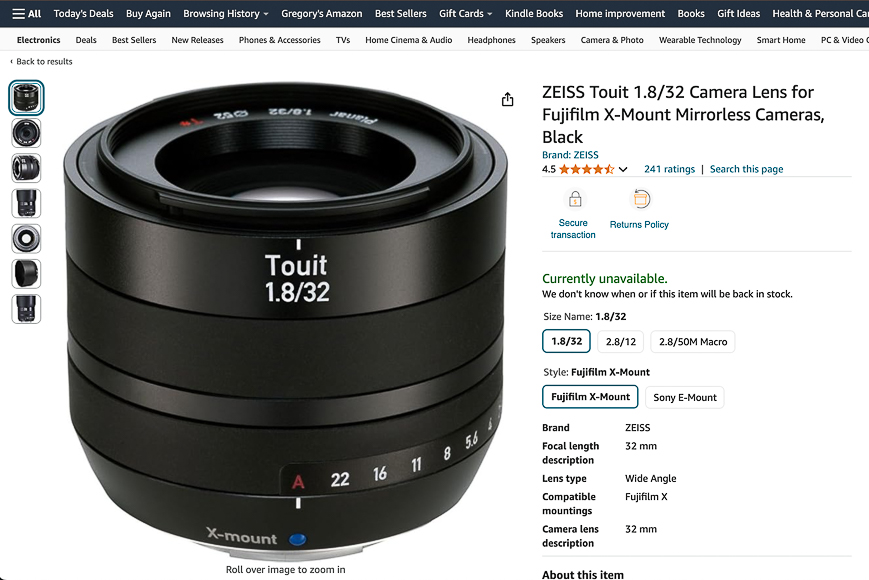
Credit: Amazon.com
I recall walking into a camera store on my first trip to Tokyo and being surprised to see a pair of premium Zeiss lenses in the Fuji cabinet.
Zeiss is a brand typically associated with Leica cameras, given its German origins dating back to 1846!
The Zeiss Touit 32mm f/1.8 and Tout 12mm f/1.2 were developed to pair with the Fuji X and Sony E mounts. Zeiss later added the Touit 50mm f/2.8 to the range.
The Zeiss Touit 32mm f/1.8 is an APS-C format lens offering a 48mm full-frame equivalent focal range.
Unlike many early third-party X-mount lenses, the Touit 32mm boasted quick and responsive direct-control autofocus.
While it’s an older X-mount lens, its optical clarity is excellent, and the fast f/1.8 aperture delivers exceptional exposure control.
Sigma 56mm f/1.4 DC DN Contemporary

Credit: Amazon.com
The Sigma 56mm f/1.4 is a fast and super-sharp portrait lens with an 84mm full-frame focal range.
It delivers tight compression, perfect for headshots, where the fast f/1.4 maximum aperture produces a smooth out-of-focus transition, subject clarity, and background blur.
Sigma’s 56mm isn’t a cheap knock-off of Fuji’s 56mm f/1.2.
Optical purity is assured thanks to a stellar lens configuration that includes a pair of aspherical lenses and a single Special Low Dispersion element.
As a result, distortion, fringing, and aberrations are eliminated while achieving excellent contrast and exposure.
Tamron 150-500mm f/5-6.7 Di III VC VXD

Credit: Amazon.com
It’s great that third-party lens developers aren’t just focusing on compact prime options for X mount.
The Tamron 150-500mm f/5-6.7 is a brilliant example of lens development pushing the boundaries of possibilities.
Harnessing 75 years in optics, Tamrom has created an X-mount lens with a 225-750mm full-frame focal range and exceptional image quality.
The weather-sealed 150-500mm boasts Tamron’s VC Image Stabilization, ideal for sports and wildlife photographers who want to make the most of the extended range.
One of the standout features is the fast and responsive VXD eXtreme-Torque Drive Linear autofocus system.
Despite its capabilities, the Tamrom 150-500mm f/5-6.7 is compact at 93 x 209.9mm (3.7 x 8.3″) and weighs 1.71kg (3.77lb).
Viltrox AF 13mm f/1.4 XF

Credit: Amazon.com
If you’re looking for a third-party X-mount lens for ultra-wide-angle photography, the Viltrox AF 13mm f/1.4 XF is an easy recommendation.
The 20mm full-frame equivalent focal range delivers a wide 94º field of view, making it ideal for landscape and architecture.
The Viltrox AF 13mm f/1.4 boasts a fast, responsive autofocus system and a wide f/1.4 maximum aperture for low-light work.
It’s one of many Viltrox AF lenses available for Fuji X-mount cameras.
You can find out more top picks in this guide: Best Non-Fuji Lenses for Fuji Cameras.
FAQ’s
Are Fuji lenses good?
Fujifilm lenses are renowned for their image sharpness, aberration and distortion correction, and excellent image quality. They’re also robust and durable and will last a lifetime if cared for properly.
What is the best Fuji lens for shooting stars?
The best Fujifilm XF lens for astrophotography is the XF 10-24mm f/4 OIS WR. The weather-sealed and optically stabilized lens delivers a vast field of view and pristine image detail.
Which Fuji lenses have image stabilization?
Optical Image Stabilization is an ideal feature for longer telephoto and super-telephoto lenses. Maintaining a steady shot at slower shutter speeds at longer focal ranges is challenging. Any Fuji lens with OIS in the title will feature optical image stabilization. The category includes the XF 50-140 f/2.8 R LM OIS WR and the XF 80mm f/2.8 R LM OIS WR Macro lens.
What does the R stand for on Fuji lenses?
The R in the Fuji lens title refers to the manual aperture ring. An aperture ring controls the size of the opening within the lens to increase or limit the amount of light passing through to the camera sensor. All Fuji lenses now feature a manual aperture ring for easy exposure control.
What is the difference between Fujifilm XF and XC lenses?
Fuji XC lenses pair with Fuji X Series cameras and feature the same X-mount as XF lenses. However, XC lenses feature simpler, less robust builds and house a plastic X-mount connection. The Fujifilm XC 35mm f/2 is currently the only XC lens on offer.
What are Fuji LM lenses?
LM refers to the type of autofocus drive system installed within the XF lens. LM stands for linear motor and delivers a much faster focusing speed than older lenses. One of the fastest LM lenses is the Fuji XF 16-55mm f/2.8 R LM WR.
What country makes Fujifilm?
Fujifilm is a Japanese company founded in 1934 as the Fuji Photo Film Co. Ltd. The company initially built film manufacturing facilities in the Kanagawa Prefecture, near Tokyo. While many aspects of XF lens manufacturing take place in Japan, the company has facilities in many other countries.
Who are Fujifilm’s competitors?
Fujifilm’s competitors include Canon, Nikon, and Sony. Each holds a substantial market share in the digital camera and lens business. Fuji has continued to expand its range and customer base by offering premium digital photographic equipment.
Who is the target audience of Fujifilm?
Fujifilm’s largest audience is enthusiast photographers looking for a stylish, compact, high-performing digital camera and lens combo for their photographic pursuits. However, Fuji also caters to entry-level and professional photographers.
Which photographers use Fujifilm?
Fujifilm cameras and lenses are enjoyed by a wide range of photographers in every genre and skill level. There’s a Fuji camera and XF lens for every genre, from macrophotography to astrophotography.
What is Fujifilm famous for?
Fujifilm is famous for its 90-year history of manufacturing high-quality film stock, optical lenses, film cameras, and digital cameras and lenses. However, photographers know Fuji for the outstanding color science employed by every X Series camera and lens.
Why I Chose Fujifilm

I’ve been a Fujifilm photographer for over a decade and have loved the brand ever since I switched from Canon.
When I took up digital photography, I was swayed by the promise of exceptional image quality and performance from Canon DSLRs.
Remember that Sony was new to digital mirrorless, and the Fuji X Series was only a couple of years old.
I opted for Canon and spent a lot on L Series lenses, which nearly destroyed my joy of photography.
Within a short time, I was lugging around big, heavy camera bags full of Canon lenses. I began to hate the idea of carting around my kit as I was developing neck and back pain.
I’d almost given up on pursuing photography until a friend and I went on a photowalk in my hometown of Melbourne, Australia.
My friend carried the incredibly portable original Fujifilm X100 with its fixed 23mm f/2 lens.
I was instantly hooked on the idea of a lightweight, portable camera system that was a joy to carry.
Of course, I bought one and soon sold all of my Canon gear to invest in the new Fujifilm X-T1 with the XF 16mm f/1.4 and XF 23 mm f/1.4 primes.
I was carrying two cameras and a pair of lenses without so much as flinching at the weight.
Furthermore, I was impressed by the durability, weather-sealing, and build quality of the two Fuji XF prime lenses.
Regarding image quality, the edge-to-edge sharpness, contrast, level of detail, and low-light performance blew me away.
I took the X-T1 and 16mm and 23mm lenses away on my first trip to Tokyo to document everything I could – they never let me down.
While the autofocus performance of the early XF lenses and X Series cameras left a lot to be desired, it’s fair to say they’ve come a long way.

The Japanese optics company has invested considerably in lens and camera autofocus detection and performance, so it’s competing with the best in the business.
I also find the Fuji XF lens range is excellent value for money, especially when considering some of the affordable variants of popular focal ranges.
I absolutely love the Fujicron compact primes, especially the XF 23mm f/2 and XF 50mm f/2.
The autofocus performance is super-fast for the work I shoot, even when paired with my older Fujifilm X-E4.
The f/2 maximum aperture delivers center sharpness, appealing background effects, and subject separation.
I’ve been out on shoots with the XF 23mm f/2 on my camera and the XF 50mm f/2 or the XF 16mm f/2.8 in my back pants pocket!
I chose Fuji over any other brand because of its portability, performance, styling, color science, and optical quality.
Final Thoughts
Fuji lenses’ quality, durability, performance, and image outcomes represent best-in-class optics.
In a little over a decade, the range of lenses has exponentially increased from three simple primes to over 44 primes, zooms, macro lenses, and teleconverters.
Regardless of your budget, skill level, or preferred genre, there’s a Fujifilm lens perfect for you.
Moreover, pairing the right Fuji lens with any X Series camera opens up a world of creative possibilities thanks to the brand’s exceptional color science and sensor performance.
Fujifilm has a reputation as an innovator in the imaging industry, having made countless technological breakthroughs over the past 90 years.
The XF lens range is yet another example of the Japanese company’s focus on developing high-quality optics for masterful photography.
From the smallest and cheapest to the biggest and boldest, there’s a Fuji XF lens perfect for your next creative pursuit.

Versatile focal length with outstanding optics in a lightweight, compact and weather-sealed body at a great price.





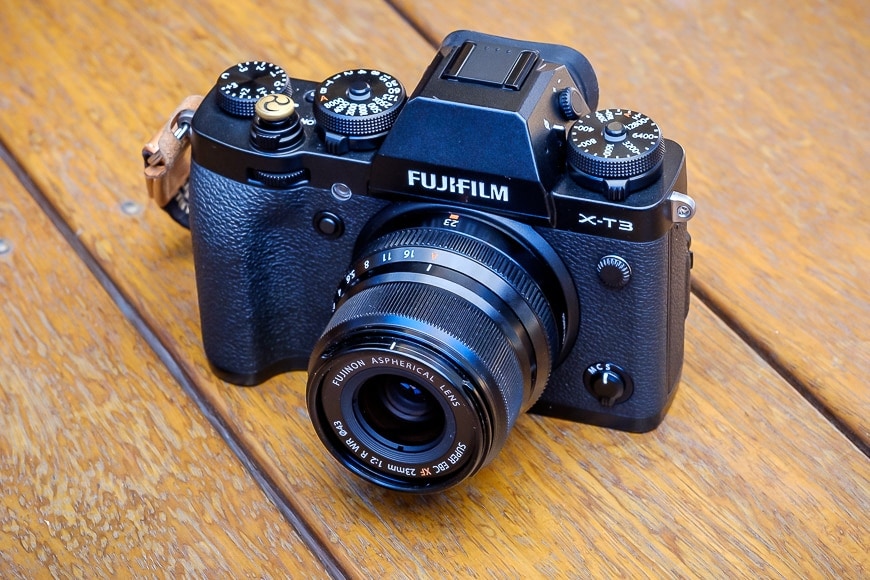
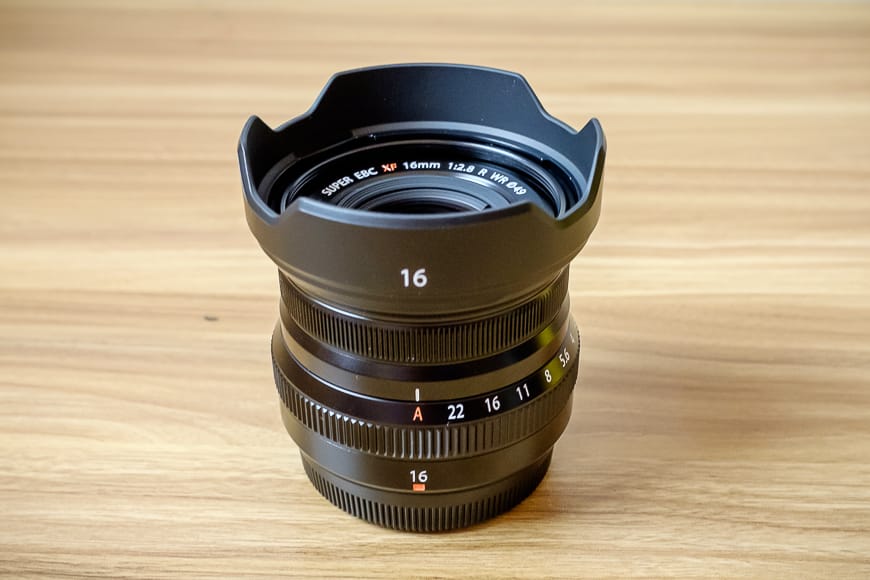

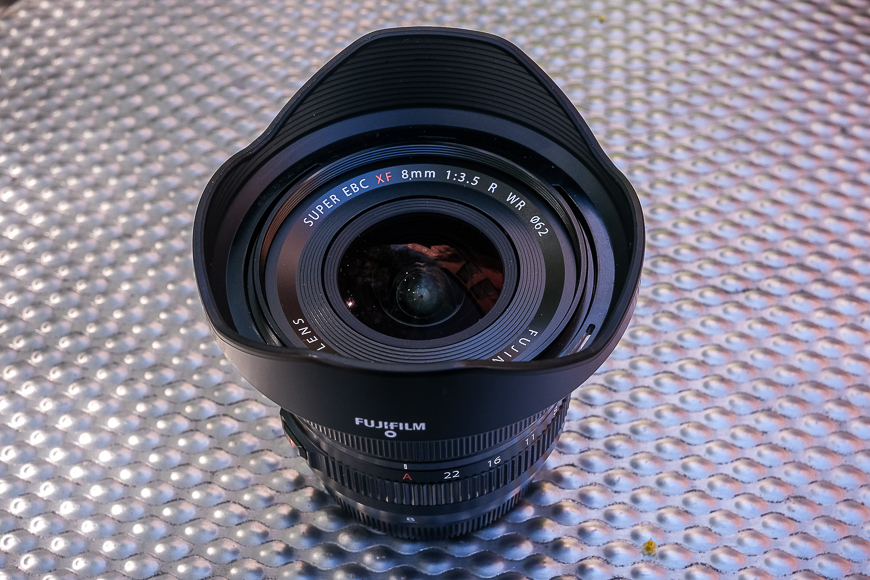




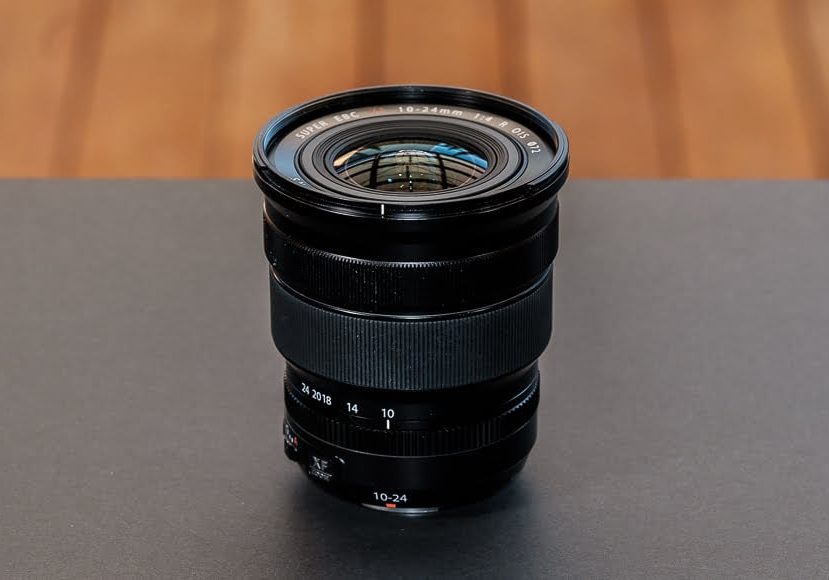

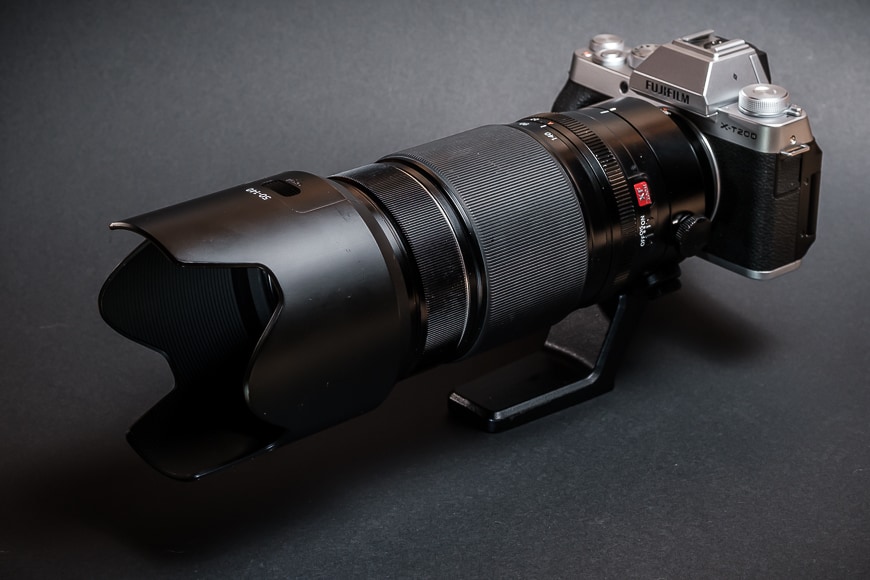




You may want to update this list and not have the header say 2024. The newest camera you mention is the X-H1, and your lens roadmap is from 2021.
Listing the 55-200 as the best value zoom is a bit of a stretch. The 70-300 is $100 more, MUCH longer reach, accepts tele-convertors, has better OIS, weather sealing, and to myself and MTF charts, a better and sharper image, at almost the same size and weight. I’ve had the 50-230 and the 55-200. I wouldn’t take either of those for free after having the 70-300. That and the lens creep on the 55-200 is comical. The 300 does not do this, CANNOT do this with the lock
You list the 10-24 f4, but not the WR version. I get that the OIS is good to have, but both Tamron and Sigma make f2.8 versions, with Sigma being smaller. (I know this list says Fujinon lenses but if there are equivalent or better 3rd party options please list them).
You list the 56mm but not the WR version which is apparently sharper. That and the existence of the Viltrox 75mm f1.2 makes this a harder choice (albeit a heavier choice).
A “must add” would be the 18mm F/1.4 even better than the great 16mm F/1.4 (I have both).
Hi! Thanks a lot for your review, it was very instructive and help me made a more clear decision. I just switched from dslr to the mirror less world and I’m pretty happy! Such a difference in size and handling.
I got myself the 23mm F2 WR as my started lens and noticed that when I focus on manual, there is a slight sound, like a little click, which then disappears when I set the autofocus. Is that a normal thing?
Thank you so much!
Altair
Congratulations on your transition!
The slight clicking sound you’re hearing when manually focusing the Fujifilm 23mm F2 WR lens is likely due to the mechanics of the lens. Many lenses, especially those designed for mirrorless cameras, have an internal focus mechanism that can produce a faint clicking sound when manually adjusting the focus. This is normal and not typically a cause for concern.
The sound you hear likely comes from the movement of the lens elements and is a tactile feedback mechanism to assist with manual focus. When you switch to autofocus mode, the motorized focus mechanism takes over, and the clicking sound you hear during manual focus disappears.As long as the lens is functioning properly, produces sharp images, and autofocus is accurate, the clicking sound during manual focus is generally not an issue.
I have a 35mm 1.4 and a 16mm 1.4, I am very satisfied with the fuji. I switched from canon after more than 10 years, now I regret not doing it earlier. There is still an 85mm on my list to buy, can’t wait :)
I am surprised that the new 33mm isn’t on there. I am tempted to invest as a replacement to my 35mm f/1.4
I had fuji xf 16-55 f2.8 and its definitely NOT as sharp as you stated at 55 the edges is so soft and sometimes its even blurry especially if there a lot of contrasty objects and most important autofocus is complete garbage for what I paid £1000 so its really a question how to trust the rest of recommendations
Hello. I am an interior designer and I am planning to buy the Fujifilm X-T3 body. Ill be using this for Interior shots of my projects, individual furniture shots and product photography for my upcoming e-commerce retail shop.
Pls let me know what is best suitable lens to buy for all of this shots.
Hi Mark,
I own four of these lenses and love them all. I switch from Nikon with all the big zooms to a Fuji XT2 with all primes a few years back after a bad car accident that made it miserable to carry all the weight. After all these years of photographing people, places and things – mostly using natural light during the day, I’ve found myself drawn to the night sky – which I’ve never photographed before. I LOVE my 90 mm F2, but while trying to photograph the moon the other night I realized that I would need something longer and probably have to give in to a zoom. Do you have a suggestion for this purpose?
Hi Mark,
I currently own a XT-200 with 15-45 kit lens. Im looking for a prime lens like the Canon 50mm nifty -fifty. However , I m confused by the comparisons with full frame focal lengths and the focal length conversions for Fuji APSC cameras . So should I be buying the 35mm prime or the 50mm prime in Fuji lenses. Basically , is the focal length to be taken at face value ?
Good question – you should be buying the 35mm prime for roughly a 50mm field of view.
Thank you for an exellent review
I was wondering if you have been testing the
Fujinon XF 50mm f/1,0 R WR
If so what are your opinion
best regards
Niels
We have a review coming up of this incredible lens, Niels!
Thank you Mark
I couldn´t wait for the review so i got one myself
It´s incredible
Was this article released last year or the year before? I feel as though I have read this before .
It was released in 2019, then updated 3 times in 2020, and we’ll update again multiple times in 2021 – we’re constantly reviewing the latest lenses and keeping this info up to date. Hope that helps!
Hi Mark,
Thank you for writing splendid explanation on Fuji lenses! I am an amateur photographer who owns Fuji XT20 with 18-55 mm lens kit. I normally use the camera for traveling (street photography and portrait). While I appreciate the versatility of the 18-55 lens kit, I do feel it’s quite heavy/bulky/noticeable for me to carry it around while traveling and I slowly feel reluctant to use it due to its weight.
Hence, I am looking for a compact, all-rounder lens that is affordable, light and not too expensive. Based on your article, will you recommend Fuji 23mm f/2 WR and Fuji 27mm f/2.8 for my needs? If you have to choose one lens only for my traveling style, what would you recommend to me?
Hey Jess – I’d start with the 23mm f/2 for your travelling needs! Bon voyage :)
Thank you for your your recommendation, Mark. I checked your article about the best compact camera and it seems Fuji X100V is really good. May I ask if Fuji X100V produces similar/better image quality like Fuji XT20 does? I am contemplating if I should keep Fuji XT20 or if I should get Fuji X100V instead
The image quality is very similar – obviously, the advantage of the XT20 is that you can change lenses, so depending on your needs, it may be more appropriate for you. I’d stick with the XT20 and just try out a prime lens – I think you’ll be pleasantly surprised ;-)
Thank you for your recommendation! Really appreciate it.
Hello, I am about to order the new XT4 as my first Fuji camera. I used a manual Nikon FM2 years ago and like the way the Fuji is set up. I intend to use it for travel, architecture, landscape, street, macro and abstract photography (maybe some video too). I’m a recent retiree and want to develop my skills. So which kit lens for a start? Do you have a list of pros and cons for the 18-55 versus the 16-80? Thanks in advance for your assistance.
Hi Bill, no pros and cons list of those two lenses I’m afraid, but my preference would be the 18-55mm out of those two. All the best!
Torn between these two as well! Any reasoning for this choice?
Hi there,
I have X-T10 and currently use FUJIFILM XF 18-135mm f/3.5-5.6 R LM OIS WR Lens, and would like to get another lens with more zoom. It is worth buying 55-200mm f/3.5-4.8, typically would use it on semi daily basis for travel, & close up moon shots, birds, flowers, hikes etc.
I also have Fujifilm XF 10-24mm f/4 R OIS & FUJINON LENS XF56mmF1.2 R APD lens.
Any guidance would be helpful, many thanks!
Monica
Those are some nice lenses you have there, Monica! The 55-200 is another great one, that should cover your long distance shots too.
Get 50-230, light, cheap and optically very reasonable.
The 50-230 is a very good lens yes you change aperture in camera but soon get used to that I have had some really nice photos with this under rated lens .
Hi! Thanks for the great content. For someone on a budget, what lens would you recommend? I’m primarily wanting to shoot landscapes and some portraits. I recently got the X-T200 and have the 15-45mm lens kit, but wanted to try out something new.
Hi Umreen, the #1 lens on this list would be my recommendation!
Awesome! Thank you so much :)
Mark, Do you have any thoughts on the new 16-80 mm lens?
I am looking to replace the 18-55. I used my old Nikon 24-120 quite a bit and liked the focal length range when I didn’t want to carry too many lenses. For my pair of X-T3’s, I have also the 10-24, 55-200, 50-140, 35 mm f/2 and the 60 macro. I also have a Rokinon 8 mm fish-eye and a Samyang 12 mm for shooting night skies.
That’s quite a lens arsenal you’ve got there already, Jerry! The 16-80mm is another excellent Fujifilm lens if you don’t require a large aperture. We’ll be doing a full review of it soon, and may possibly have to update this article!
Hi Mark,
There is one thing that bothers me in this article, it’s the lack of any photo credit… There are definitely pictures from other photographers here such as Jonas Rask and no mention of them… For a photography-related website, that is strange… and disappointing…
Good article though.
Hey Frederic, thanks for pointing this out – it’s a caching issue that we’re trying to get fixed. Check back in a few hours and they’ll all appear back again in the captions (you can check waybackmachine to see the previous version of this post, which showed all the credit).
Hi mark
What is your opinion of 18-135?
embrace of the azores
Fantastic all round lens a great walk about crisp and sharp
Hi Mark, great read. What are your thoughts on 80 macro over the 90 which doesn’t have IS? Was thinking of the 80 for it’s dual capability of macro and portrait. You have now also made me think about the 55-200, I have been put off by the f3.5-4.8 as I use primes 16, 35 and 56. But will look into it as a handy one to have maybe over the 80 or 90 in the bag.
I would love to add the 23 f1.4 but I already use the x100f and I don’t feel I need to double up on lens. Do you think the 23 f1.4 is a lens to always have in the bag, considering my other primes that is?
Hey Lyn, sounds like you have a good collection there! I also have the x100F and agree that the 23 1.4 feels a little like overlapping, although the difference in bokeh between the f/1.4 and f/2 (of the 23mm X100F) is notable. As you’ve got a good range of primes already, the 55-200 might add some versatility, when you don’t have time to switch lenses. I love primes too, but every time I use a zoom, I wonder why I don’t use them more often – it’s lot of fun being able to take several different focal length shots, just by twisting the barrell ;-) As for the macro question, yes the 80 is a great lens, as long as you have adequate light. If not, IS is definitely useful. You could use the 90 to shoot portraits too. Hope all that helps?
50-140 f2.8 zoom in low light.
My lens struggled at dusk shooting a football match with weak floods with XT-2 body but much improved switching to XT-3 body. I think more a sensor/processor issue than the lens.
Though it weighs 1kg it is my favourite Fuji lens of the three I have; 18-55 and 10-24.
Thanks for the feedback, Richard. Were you really pushing the ISO on your XT-2 to compensate?
Thx , great article but What about best Macro lens?
I’d recommend experimenting with one of these first, Ronen: https://amzn.to/2FI71QU – might be a cheap way to get the macro shot you want before dropping the big bucks ;-)
Hi Mark! Wow, what a great updated review! Just superb! Don’t want to be a „letter-peeper“, but in the techs of the very first lens, Fuji 55-200mm f/3.5-4.8 there is a typo in the Aperture value: it says f2.5. With that, the lens would be just magnificent:-)
ahhhh haha nice spot, and thanks Nikita! I’ll have to fix that ;-)
Greetings! I was robbed and lost a Canon 50 megapixel body and several lenses. A close friend turned me on to Fuji so I switched and as mainly a wedding photographer post editing for color adjustments is so much faster. The skin tones are dead on with the new Fuji X-T3. I will never shoot a wedding without dual cards. Short background. I’ve shot about 2000 wedding staring in 1987 with Hasselblads. Times have changed! 200 images was the right amount for a wedding, because each tine you fired the shutter it would cost about a dollar; the cost for film and developing, plus the proofs! Now it’s 2000 or more. The X-T3 allows us to shoot about 12 frames a second.
Anyway, what about the 100-400 lens. I bought it but haven’t shot with it yet. Didn’t like the 100-400 Canon too much so I would use the 1.4 converter on the 70-200 AF2.8.
I sill get to play in the woods a lot and I’m near Yosemite, and other great parks. Would you buy the 50-140 and maybe buy the 1.4 or is the 100-400 a pretty darn good lens?
If I may add a note for dedicated flash units the flash I use is the Nissin Di700A, make sure its for Fuji! The best part of this flash unit are just 2 controls. A SET button and a WHEEL. Lets say you are underexposed well you just move the WHEEL in 1/8 increments until you get the exact exposure. It’s also very accurate, from closeup ring shots to about 15 feet back on TTL. Then switch to manual with the wheel and press the set button! It’s that easy. The Canon flash units have too many buttons and frankly you might miss several shots trying to set the flash unit from ETTL to Manual, then 1/2 power or 1/4 power.
Thanks for your great articles and valued information. Bob
Thanks for the informative comment, Bob! I think you should join the Shotkit Private FB Group – something tells me you’d enjoy it there with your enthusiasm of photography/gear ;-) Will answer your questions there, since they’re rather specific.
Hi Mark. Loved your article! Right now I’m a little divided between Fuji bodies, so if you coul help me a little I would be really happy. I’ve been working as a second camera on weddings using a borrowed Nikon D5300 and I’m looking to buy a Fujifilm camera but cant decide between the XH-1 or the XT-3 because I dont know if the IBIS is that much of a turning point in wedding and traveling photography.
Sure Felipe, thanks for the kind words. It’s a tough one – they’re both great cameras. The IBIS in the XH-1 really helps in low light to keep your ISO low, but I think the X-T3 is an all round better camera for weddings. You can’t really go wrong with either. One thing I would say though it to by plenty of batteries – you’ll need at least 6 for a full wedding.
I am missing a test of the 18-135 I used with XT1 XT2 !
Great article but nothing about de 18mm f2 ? 80% of my work is doing with that lens. A great focal length for reportage !
Ah it’s a great lens for sure, Cedric . Do you also shoot portraits with it?
Thanks for the comprehensive and practical coverage of Fujifilm lenses. Just a point on the 23mm f2. I bought this last week for my new X-T3 and on using found that the image was blurred at f2. Lens is only usable at f5.6 and beyond. I was shooting an object at 10M distance. Not sure whether the lens is faulty or its a design flaw. Any comments would be much appreciated.
Thanks Shane. Sounds like a dud – I owned the 23mm for 6 months and it worked fine for me, especially wide open.
Thanks Mark, I’ll try to get a replacement. I’ts not that easy to replace items in Australia. regards Shane
Shane it is rally easy to get a replacement in Australia. We have some of the strongest consumer protection laws. If you have trouble with a retailer point them here
https://www.accc.gov.au/publications/consumer-guarantees-a-guide-for-businesses-and-legal-practitioners
Thanks for the in depth view on the Fuji lenses. I enjoyed reading it!
Looking for something nice next to my 35mm F2 on my X-T2.
Hi Mark! I really enjoyed your review but it left me completely tangled as I want all of these lenses now! I have X-T20 body and 18-55 kit lens plus I bought recently 35mm f1.4 lens. What other lens would you add for travelling/ landscape/ architecture/ night photography? I was thinking I would like to get maybe 10-24mm or 16 mm. Which one of these would you prefer? I also consider whether I need 23mm f1.4 or (f2 lens) or not…
Hey Ingrid! Yes it can get a little confusing which lenses to buy. By the sounds of it, you need an all in one lens that’s versatile enough to cover a whole range of situations, and preferably be light enough to use on your X-T20 for travel. In that case, I’d recommend the 23mm f/2 – there appears to be a sale on Amazon here if you apply the coupon. Hope that helps!
Hello! Just found this article and found it very informative. I recently passed my Nikon D5500 (two lens kit) on to one of my sisters so she and her husband would be able to take quality pictures of their growing family. Since then I’ve been making due with my Samsung Note 8 for my recent photos. I don’t particularly mind whipping out my phone for some quick shots, however, I have really been missing the camera experience and wish to return, minus the bulk! I’ve been researching and reading up extensively on Fujifilm’s X-t options and I believe I’m aiming heavily toward the X-t20 as a budget friendly choice.
So, my question is, (I suppose I should preface with the fact that I prefer landscape & nature/city street & architecture shots) would you say the 18-55mm lens that comes with the kit is a good lens for those uses?
Hi Michal! Thanks for the long comment. Yep, the 18-55mm is a great lens to use initially with any Fujifilm camera, and definitely suitable for landscape/city or anything that requires a fast focal length change from wide angle to telephoto. I say ‘initially’, as it’d be a shame not to explore the full capabilities of your chosen camera with one of the prime lenses on this list! All in good time… ;-)
Excellent article sir! I certainly agree with most of your recommendations, such as the 23 f/2, 90, 16-55, and 55-200…all superb lenses in my experience with the XT-1 and X-Pro2. My only addition, and this is an important one, is the new Fujinon XF80mm f/2.8 Macro!! Prior to my experience with it, the 90 had been the sharpest lens I’ve ever used in 35 years of photography. I had thought I’d seen the “Best of the Best, in terms of sharpness….then I saw what the 80mm is capable of, and frankly, it’s astonishing!! I cannot imagine a sharper lens, and look forward to seeing the images with that plus the upcoming XT-3 with an updated sensor and engine!! I do product photography and focus stacking with the 80 and X-Pro2 (with a solid tripod of course), and the results rival FF or even medium format, at least in terms of image sharpness and detail! Thanks again, Steve
Interesting comment Steve! I’ve used the 80mm but only for a few macro shots to test it out quickly – will have to spend more time with it next time! Cheers
Hi Mark! Thanks for a great review of Fuji lenses. Was very interesting to read your thoughts on all of these lenses, but especially for 55-200 and 90 mm. By the way, in chapter 7 on 90 mm the image shows 56mm lens ;-)
Hi Nikita – thanks so much, and how eagle-eyed of you to spot that mistake! I’ve fixed it now :-)
I probably like 56mm so much that can recognise it on every photo ;-)
Great job, awesome content!
haha it’s definitely got a distinctive look when shot at f/1.2!
Great read! I read the above information regarding your top lens recommendations for travel. I’m interested in the T2 for travel as well as camping/hiking trips. Would you change your suggestions for lens? I’m mostly interested in lenses with WR due to mother nature :) Any recommendations for flash?
Hey Jessica – it depends! Do you need a zoom? Personally I prefer a small lightweight fixed prime like the 23mm. As for flash, you have a few options too. Godox do some very affordable ones that work in TTL with Fuji. Hope that helps!
Mark,
What are your thoughts of using 56mm f/1.2 vs zoom 55-140mm f/2.8 for shooting portraits? I came across another photographer’s recommendation to use zoom lens for portrait because it’s more flexible. Bokeh can be created with stepping further away and zoom in.
My preference would be the 56mm Tracy. It delivers a unique look not possible using the zoom, and you may not always have the room behind you to step back far enough to accommodate the entire range of the 55-140mm for portraits.
I really enjoyed this article, but I’d caution that your notion of Amazon as an impartial customer review system in which the community honestly votes reviews up and down is a bit naive. Not only are many reviews on Amazon subsidized or simply fake, but the competition that Amazon breeds with its reviewer rankings distorts voting behavior among both reviewers and merchants. There are many excellent, honest reviewers on Amazon, and a close read of their review history will help you identify them; but in the end, it’s best to take what you see on Amazon with a grain of salt.
Something to keep in mind – thanks Brad.
Hi Mark!
Now I am clear, XT2 is just everything I need. The look, size, color, style, resistance, yp. I am a constant traveller and looking for a gear to have with me, for pro street, landscape, and once in a while a portrait sessions. I am a Nikon user, and I was into d500 or 850, but due to its size, d500, but it just feels to heavy to carry around all the time, and Fuji, perfect for street walks, or getting lost in the wilderness, and shooting nature, animals. So, what I need, is the lens. I would be more than happy to have one only, all rounder, but, in order to get a better quality, yea, two are just fine. One for everyday, street, close ups, and the other one for wildlife, streets as well. I went through ur article, and some others, but I just stoped. I need your answer. I ve heard, 16mm is the perfect lens for everyday use. But, you are here to help with the answer. So, one for everyday, and one telephoto. The price? That’s fine.
Thank You!
Hello,
I’m thinking of switching from my canon to the Fuji Xt-2. Currently traveling the world doing lots of travel photography (landscape, portraits, temples). Wanna build a kit that would let me do all of those things but with only 2 lenses, since I am traveling and don’t want to cary to much gear. What would you recommend for the 2 lenses? And if you were to have a 3rd lens, what would it be?
Thank you
Marc with a c
Hey Marc with a C! For travel, I’d recommend these 3 lenses: 1. 23mm f/2 for everyday walk-around and 90% of your photos; 2. 18mm f/2 for wide angle shots (the 16mm is also excellent but it’s much bulkier and more expensive); 3. I wouldn’t take anything else! But if you want one more, I’d consider a zoom like the 55-200mm f/3.5-4.8. I hope that helps!
Thank you very much!
HI Mark!
Constantly refer to this article of yours when looking at lenses for my XT2!
Wanted to ask, what is your opinion on the 60 mm f2.4 fuji lens? I’m looking into it for some macro photography!
You also sold me on my 23 mm f1.4! Got it and love it! Hasn’t left my hit since!
Great, Aury! Yep that 23mm is an awesome lens. The 60mm f/2.4 macro is another great lens, but obviously very specific in its usage (being a macro). It offers good colour rendition, minimal distortion and is very sharp like the 23mm too. It’s a little slower to focus though. If you decide to buy it, please use this link to help support what I do here. Thanks!
I have an X-T1 with the 35mm f2 which I love. I’m now considering the next lens to get. I like shooting streetphotography and landscape.
Im thinkink of either buy a wide angle such as the 16mm f1,4 or a more zoom lens like 55-200.
My new lens would be for more landscape, which do you suggest?
Great article!
Thanks Mikael. It’s hard to compare a wide angle with a mid-long range zoom as they’re completely different lenses for different purposes. I guess the easy answer is, decide how much you need to fit in the frame!
im a fuji convert from nikon and m43 i currently own the 56mm 1.2 the 10-24 the 18-55 35 1.4 the 55-200 and 14mm 2.8
I agree the the fuji lenses are indeed superb and found this survey useful for helping me decide to get the 50-140
thanks for a great article
You’re welcome Paul. Thanks for the feedback!
The 16-55mm f/2.8 lens is weather resistant whereas the 18-55mm f/2.8-4 lens is not but it does have built in OIS which I would have thought gave it a significant advantage in low-light conditions (as well as being much lighter and less bulky) or do other factors need to be taken into account ie focussing speed, resolution etc
My camera is the T2
HI~
I have fuji x-e2 Camera and want to make product photos fro blogging.
Good quality products photo of cosmetic, food, clothing…What lens do you recommend? Thanks in advance
Personally I’d use the 23mm f/2 Mara. It’s versatile and great value for money.
Hi Mark,
Nice article. I’m just wondering what lenses would you highly recommend for both portrait and sports photography? Especially for indoor sports where lighting can be quite poor. Thanks.
Sports photography usually requires zoom lenses, which unfortunately ‘eat’ stops of light. If you can get away with the 56mm f/1.2, you can shoot in low light, but the reach may not be enough for you. Otherwise, any of the Fuji zoom lenses which have large apertures are your only options.
Hi Mark. I beg your pardon for my bad english. Fujinon 23mm f 1.4 has 7 circular blades and it is more expensive, the 23 mm f 2 has 9 rounded blades but it’s more cheap. It seems a nonsense. So: 1) what does it mean “circular” (Photozone) and what does it mean “rounded” (Photozone); aside the bigger aperture of 1.4 is this (circular/rounded) that also makes the difference in price? 2) Which has the nicer bokeh in your opinion? Thank you.
Hi Roberto. Your English is fine ;-)… but I think you’re worrying too much about the details of these two excellent lenses! Don’t worry about the aperture blade number or shape. The f/1.4 bokeh is smoother, but you won’t notice unless you do a direct comparison with the f/2. The f/2 has weather proofing and is lighter, so it’s a great value lens. Unless you need to shoot in low light often, I’d get the f/2 and use the money you save for your next lens!
Hi Mark!
I currently have a Fuji X-T1 with kit lens 18-55m f/2.8. I’m interested in street, architecture, and landscape. If I were to get another lens, I’m thinking something wider and lower f stop. I think I want the 16m f/1.4 but do I really need it? As for the 23m f/2, is it too similar to my kit lens? Does it make a big difference from f/2.8 to f/2 in term of allowing more light?
I’d say stick with that kit lens unless you’re shooting in low light a lot and you’re not satisfied with using higher ISOs. There’s not a massive difference in light gathering ability of f/2.8 to f/2, but it can be the difference between pushing your camera’s ISO just that little bit too far or a relatively ‘clean’ shot.
Hi Mark!
I’d like to have your opinion and hope it’s not too late today!
I recently paired my XM1 with Zeiss Touit 1.8/32 and it was incredibly stunning! I am planning to have the 12 mm Zeiss next for wide angle. (Maybe for some combo mix)
Do you think it’s the best option or somewhat comparable with any listed Fuji lenses above?
Hi Osman, I haven’t used that lens so can’t really comment. If you’re happy with the results, I’d say stick with it!
I have the 32 Touit on my XPro-2. It is stellar. I had the 12 but was not a big fan of that prime focal length. I have the Fuji 14 f2.8 and I like it more. It is more useable and more portable. From everything I have read, the 3 best Fuji lenses are the 16, 56 and 90. Case closed. I only own the 56 at the moment.
Hi
Thanks your articles have helped crystallise which mirrorless body to go for. Great article on the lenses too. I’m off to Cuba with the Mrs soon and looking for a lense to leave on the body for the trip for a mixture of picture types I.e landscapes and portraits You’ve not mentioned the 18-135 lens in your article. What’s your opinion on this lense or would you suggest I go with the 16-55 f2.8?
Regards
Simon
Hi Simon, glad it’s been useful. I’d go for the 16-44 personally as I prefer that zoom range but if you need to take photos of things that are further away, go for the other one. They’re both excellent. Also, weight may be a factor you should consider too.
Hi! Great article!
May I just ask, what would you recommend for a “walk around” as well as a “wide angle” lens? I am into street + landscape photography rather than doing portraits. Plus, an easy to carry kind especially using a mirrorless fuji camera (x-m1).
I’m planning to purchase a 27mm f2.8 fujinon lens. Would it be at least worth my needs?
Cheers!
Jill
My walk-around/wide angle recommendation would be the 23mm f/2. It’s water resistant, fast, light, fast to focus and affordable. Good luck Jill!
Great article. Thank you. I’m a new XPro2 user with a 23mm f/2 in the Graphite kit. Now deciding on lens #2. I’m switching from Nikon D810 to mirrorless.
Thanks Chuck. I’m also switching from Nikon (D750) to mirrorless :-)
Nice article!
I have 2 questions:
1) What lens is the best for traveling and street photography? 23mm f1.4 or 35mm f1.4?
2) Please, could you tell me what is the black leather strap attached in the picture of the two X-Pro2? It is beautiful and I would like to buy it fot my XT-2. Could you share the name and the place where I can get it?
Thanks!
1) Depends how close you want to get to the subject! I’d go for the 23mm personally. 2) You should leave a message for these guys: https://shotkit.com/nordica/
I found out for you about the straps: https://rebeleast.com/sklep/rebel-slim-black/
https://killspencer.com/products/camera-strap
what about the 100-400 ?
Good but not an all-round lens, plus way too big for the smaller X bodies imo
Hello, this was a great read. I actually own a canon rebel and am trying to decide on an upgrade. I like full frame but for the features i would like, the full frame would be too costly. So im thinking to go with a quality crop sensor camera and am trying to decide on either a fuji x-t20, sony a6300 or sony a6500. I am leaning towards the x-t20 but am wondering whether i can use any of my canon ef mount glass on the fuji with a good adapter. Are there any you recommend especially those that can keep AF with the canon lens? And i just wanted to confirm, but are all the fuji lenses you reviewed autofocus and not only manual focus? Thanks
I’d always recommend using Fuji glass on Fuji bodies
Great article thank you. I am hoping to write an article in the near future comparing the older 23 F1.4/35 F1.4/56 F1.2 trinity and the newer f2 WR trinity. My problem is I can’t get the new 50 f2 WR off my XPro 2. Such a great lens. Check it out if you can. Thanks again for the read.
Ah yes the 50 f/2 is another great one. I prefer a 35 focal length to a 50 for versatility, but for portraits with a little environmental context, it’s hard to beat a 50.
I know this is outside of the scope of this article but was wondering about how some 3rd party lenses would stack up against these. I have used a few Samyang lenses (sold under the Rokinon brand) that are amazing. The 12mm and 85mm are two that come to mind.
3rd party options for the major brands is a future post I’m planning Michael :-)
Hi there, love your article. I remembered buying my first prime lens thank to you without any regret!
I definitely agree with Michael; 4 years later i’m interested to see the integration of third party lenses like viltrox in your top as we have definitely great options now from other manufacturers. Any plans?
Nothing for the time being, Renaud – I still think the Fujifilm lenses are the best options right now.
I’m a fairly recent convert from Pentax. Unfortunately, or fortunately depending how you look at it, I only have the 16-55mm F2.8. Eventually I hope to get most of these lenses, but at the moment I’m really looking forward to getting the 50-140mm.
Thank you for these excellent reviews.
I own the X-T20 and am loving the Fuji experience. First, would you recommend the 100-400 for this camera? I’m sort of hooked on zooming right into my subjects and miss the flexibility of the Nikon 18-300 lens. I’ve no desire to use a tripod. I do love the quality of the images I get with the Fuji though and have no regrets.
In time I’d like to get one of the top Fuji cameras as my main body. Is the T2 the best overall, do you think?
Hey Simon. The 100-400 is a great zoom, but I’m not a fan of putting a large lens on a small body like the X-T20. As for your other question, the X-T2 is the flagship camera, so I guess you could call it the best. It depends what you need it for though – the X-T20 is more than adequate for 90% of situations imo.
Hi, Can you help compare the XF23/f1.4 R vs XF23/f2 R. The f/2 seems newer, WR, faster focussing, yet is cheaper than the f/1.4. Is the f/1.4 sharper? Any reason to go for the f/1.4 lens over the f/2? Thanks and great article.
Hey Dan, good question. I tested them both first hand for a month so feel I can answer this one well. Aside from the obvious difference in apertures which will affect depth of field and low light performance, the f/2 and the f/1.4 are very similar in performance. 2 great things about the f/2 version – it’s smaller/lighter (although somewhat of a strange looking lens!), and it’s weather proof. I ran my XT-2 and this lens under a tap and it worked flawlessly. I’d say, unless you shoot in very dimly lit venues or are a complete bokeh-whore (!), stick with the f/2. Hope that helps!
Dan, while I don’t own the 23 f/1.4, in terms of sharpness, I can tell you that the 23 f/2 is perhaps my sharpest lens, right next to the stellar XF90! Plus, if you have a WR body, it’s a no-brainer.
[Correction] I meant to state that my ex-rig was a Canon EOS 7D MK II (Great camera but constantly shooting on high-speed shutter (10fps) for motocross events I’d pushed the shutter count way past 200,000 and the body was worn and has lived in the dust and mud for two years, so it was time for a change).
I’m using the XT-2 with grip on 14fps with the electric shutter and the results are superb. No violent mirror flapping action and mechanical shutter banging away; life is quite and smooth and no moving parts has got to be better for the camera body.
Hi – Great article and appreciate the detail. What are your thoughts on the Fuji 100-400mm f/4.5-5.6? I’m primarily looking for equipment for wildlife photogrpahy and now having settled on the Fuji X-T2 and torn between this and the 50-140mm f/2.8.
It’s an excellent lens, Susan. I didn’t include here simply because I thought it was a little too niche for the everyday user.
I am a recent convert from Canon to Fuji. I like wildlife and sports (motocross) and my ex-rig was a Canon EOS MK II (with vertical grip) and EF 100-400mm f/4.5-5.6L IS II USM Lens. Moving to the Fuji X-T2 with power grip and the Fuji 100-400mm f/4.5-5.6 lens I’ve lost nothing except some bulk and a ton of weight. I’m enjoying the new kit very much and learning to love it more as I suss the best tracking AF mode for my purpose. I get such beautiful JPEG images straight off the camera with the Fuji that I’m spending far less time with the sliders converting from RAW. The Fuji 100-400mm f/4.5-5.6 is sharp with good (fast and accurate) AF characteristics. It feels well made and robust. The OIS is quite amazing too. I purchased the Lens kit with the XF 1.4X WR Teleconverter included. This is a very nice bit of kit for that extra reach. I looked at the 50-140mm f/2.8 but figured for the type of wildlife and sports I shoot, that I’d need the 2x Teleconverter and have it fitted most of the time. I’d like to acquire the 50-140mm f/2.8 as well eventually, but for now, all in all, I’m very pleased with my investment in the Fuji 100-400mm f/4.5-5.6 and would highly recommend it.
Really interesting insight, Richard – thanks for sharing this with us. I’m sure there are many photographers out there thinking about doing a similar switch from Canon to Fuji ;-)